This should work: https://wondermyway.com/2023/06/30/lake-living-summer-issue-2023/
Should.
Thank you for your patience.

This should work: https://wondermyway.com/2023/06/30/lake-living-summer-issue-2023/
Should.
Thank you for your patience.
Dear Sis,
This one is for you as you celebrate a special milestone.

Be grateful for the stones laid by Mom and Dad that proved to be a strong foundation withstanding time.

Be sure to take time to bask in the sun and reflect on the past and present, while pondering the future.

Be unlike the Wood Frog moms who leave the pool shortly after laying their eggs and don’t nurture their children.

Be especially proud of the children you gave birth to and the nephews you’ve also supported and the four grandsons who now grace your life.
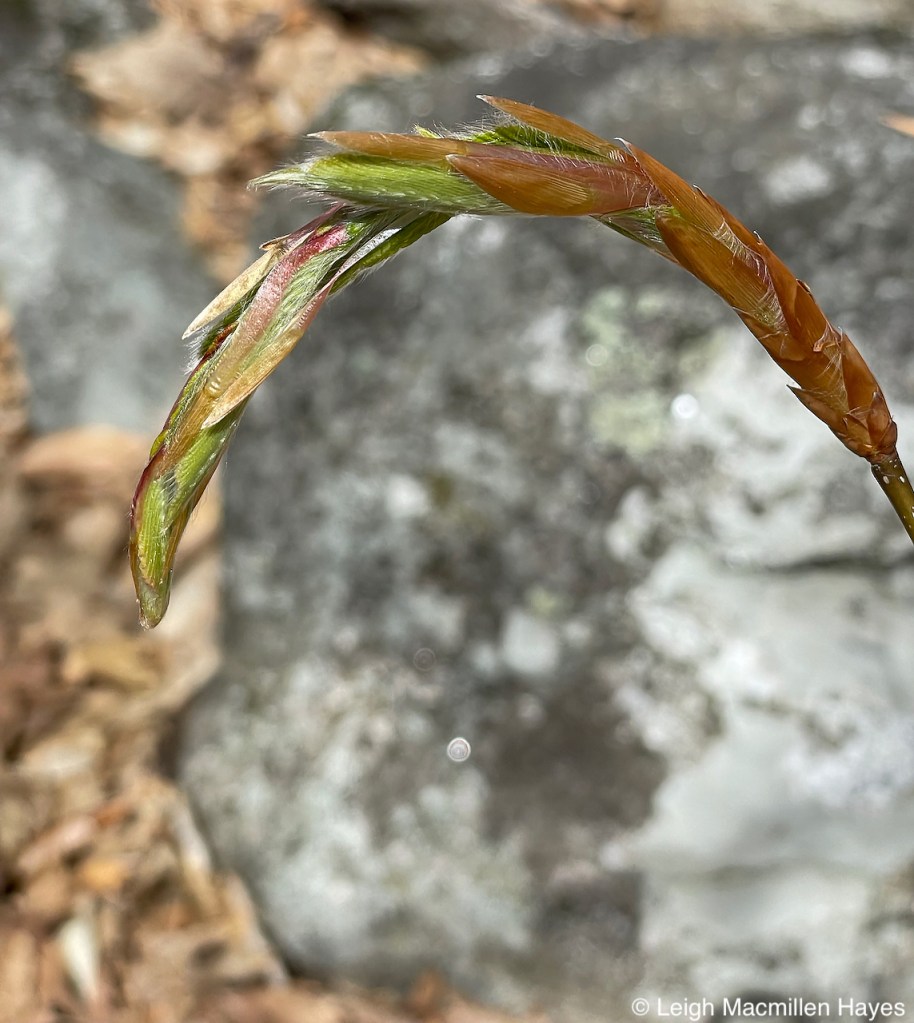
Be open to unfurling, making sure others pause to note your intricate inner beauty.

Be your true beach girl, even if you’ve traded the ocean for a pond and now appreciate a beech of another kind.

Be on the lookout for a natural color palette as you create quilts to comfort family and friends.

Be the runways of a Painted Trillium and attract pollinators to your inner goodness.
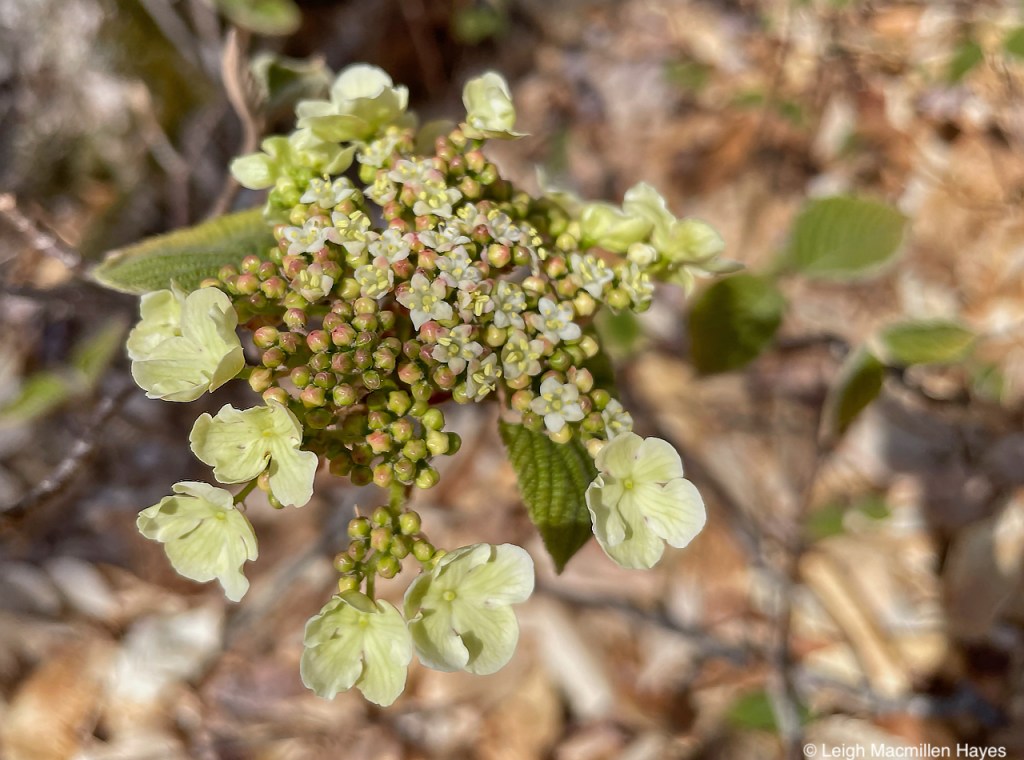
Be aware that though some may wish to see you hobble along the path, there is beauty to be found on the way.
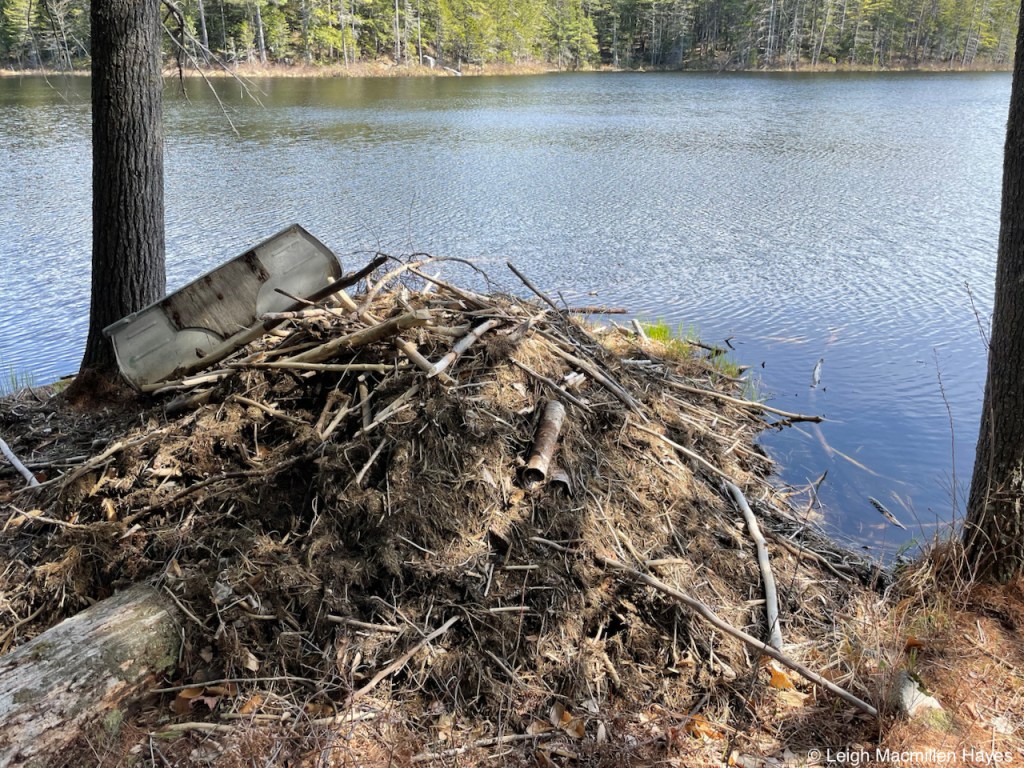
Be careful of your transportation and should it get lodged by a tree, turn it into a lawn ornament.

Be able to use your tenacious spirit to turn boulders into rolling stones.

Be an engineer and build another dam should the first be breached.

Be willing to let go of those moments when you realize you’ve bitten off more than you can chew and leave the mess for someone else to clean up.
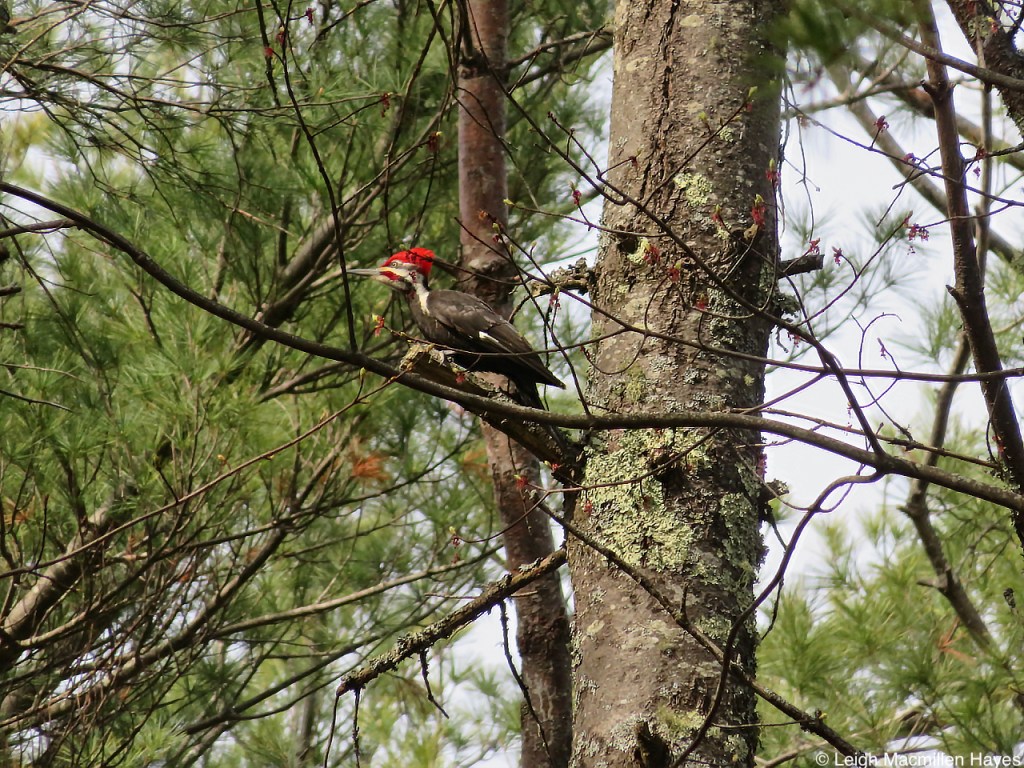
Be loud when you need to and sound off like Woody the Woodpecker when the occasion calls for it.
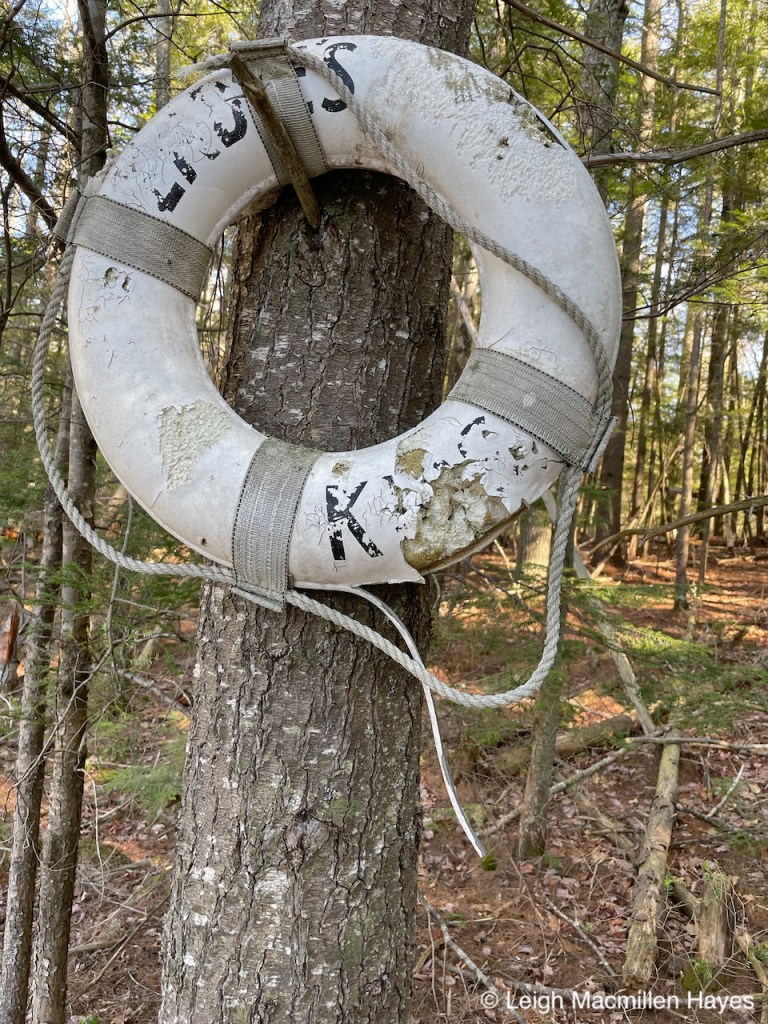
Be willing to ask for a lifeline when necessary.

Be like me and continue to follow your guy as I know you do.
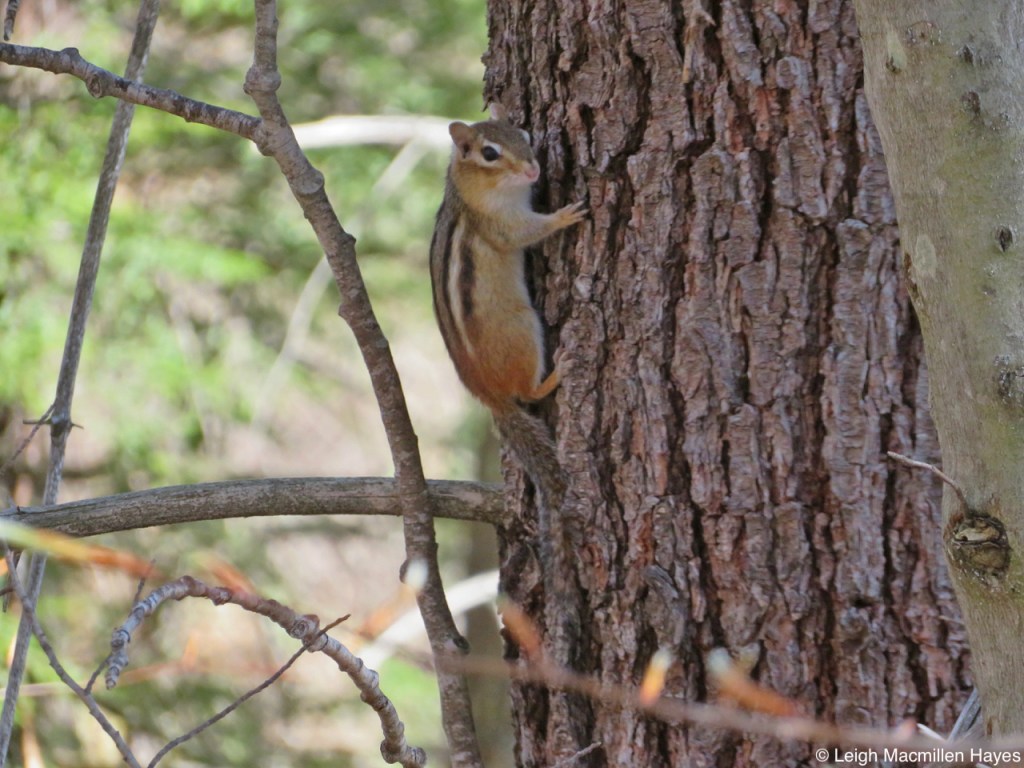
And at the end of the day, be like a chipmunk and hug a tree or all that stand still.
Be. Just be. My B.S. My Bestest Sister.
Happy Birthday to you and Happy Mother’s Day too.
Oh, and don’t forget, be like Bert and Ernie and Edith Ann and continue to lighten others spirits with your humor.
We’d hiked at least a mile and passed a few Trout Lily leaves but no flowers when I asked my guy to hunt for the little yellow beauties that delight me. And so he did.
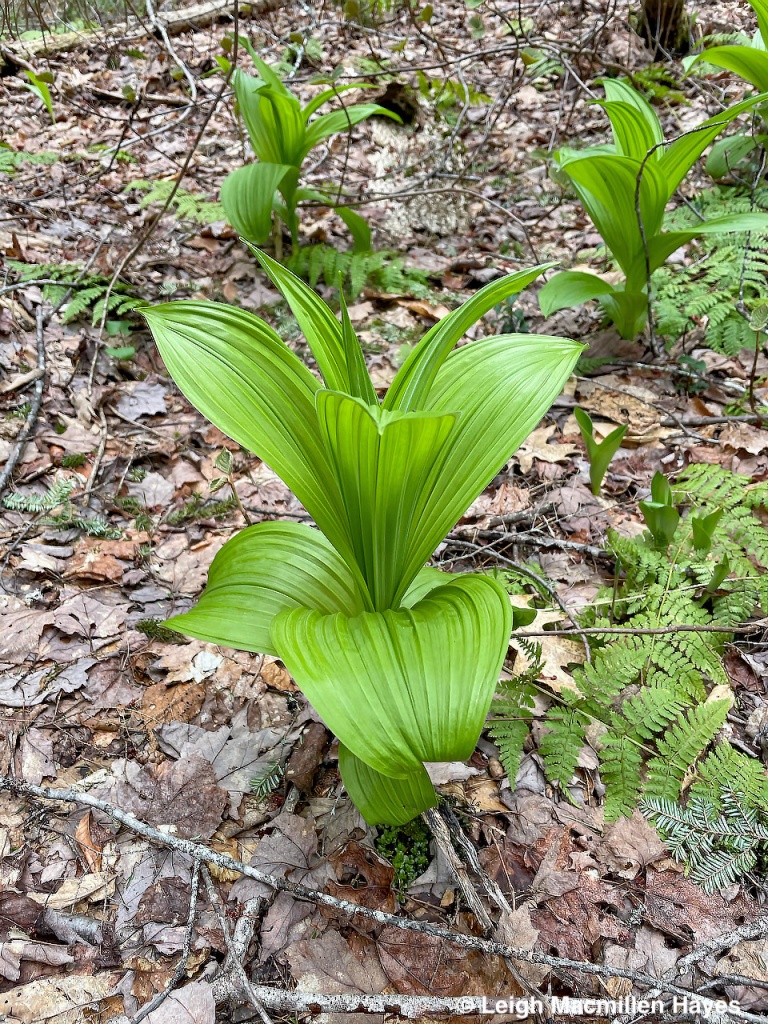
And felt quite pleased when he pointed one out to me. Well, um, how should I tell him it’s a False Hellebore and not the lily I sought. But, it is a member of the lily family, so it was a win, and I can’t resist photographing the hellebore’s spiral stalks of pleated leaves so it was actually a win/win for both of us. We never did find a flowering Trout Lily.
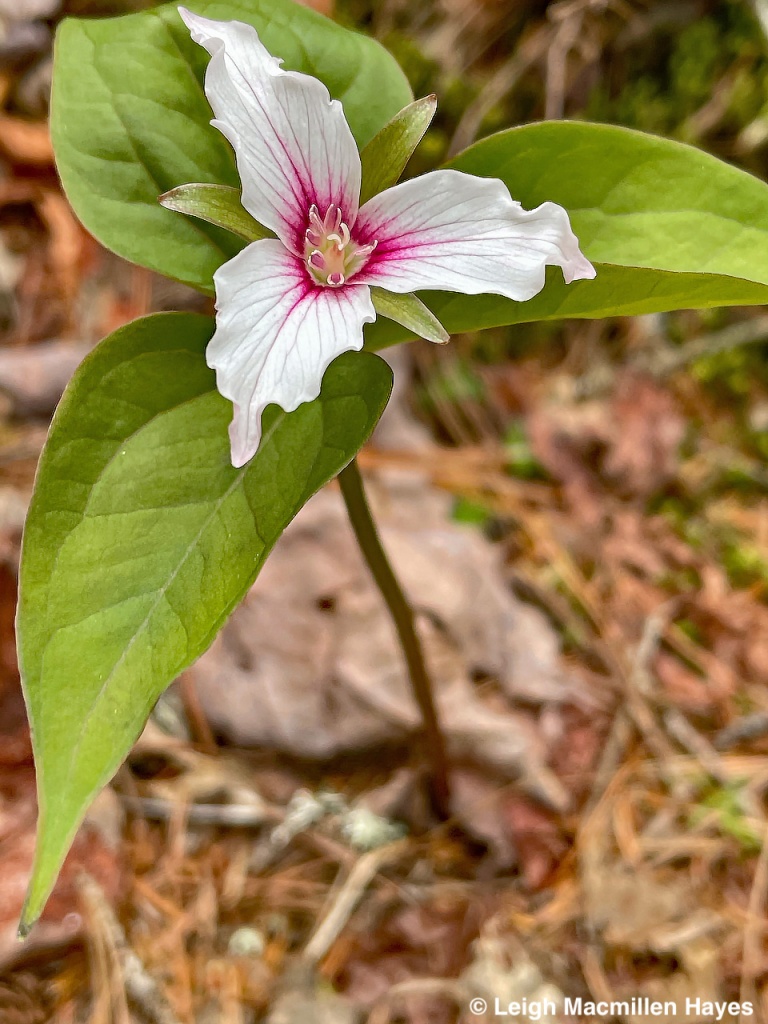
That was okay, because there were so many other flowers to honor and today marked the first day of this year that I spotted a Painted Trillium. Leaves of three (actually bracts), sepals of three, petals of three, but the best is the pinkish-reddish-purplish splotch at the base of the petals that acts as a pollinator guide.
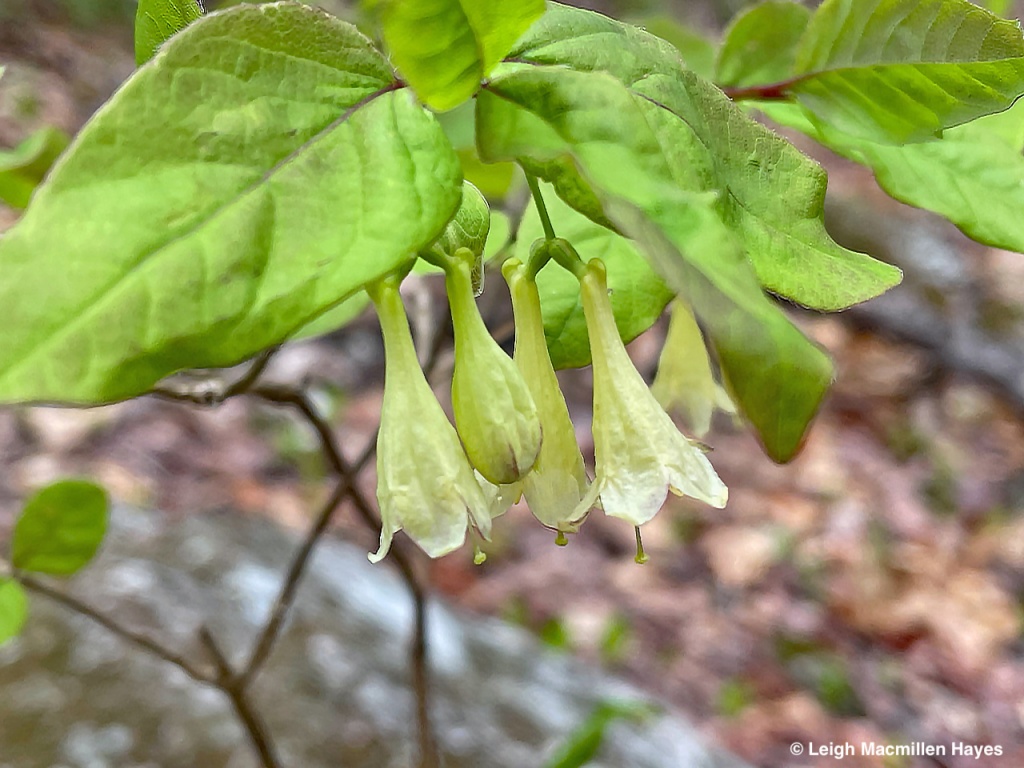
Another pleasant surprise a few minutes later: American Fly Honeysuckle, its funnel-shaped yellow flowers tinged with a hint of purple dangling like a set of twins.

Also pale yellow in hue, but with petals that curve out slightly at the tip: Sessile-leaf Bellwort (aka Wild Oat). While most bell-shaped flowers are fused, these are not. And they are most subtle in appearance so you really have to focus to locate one. But chances are that once you find the first, your eyes will cue in on others.
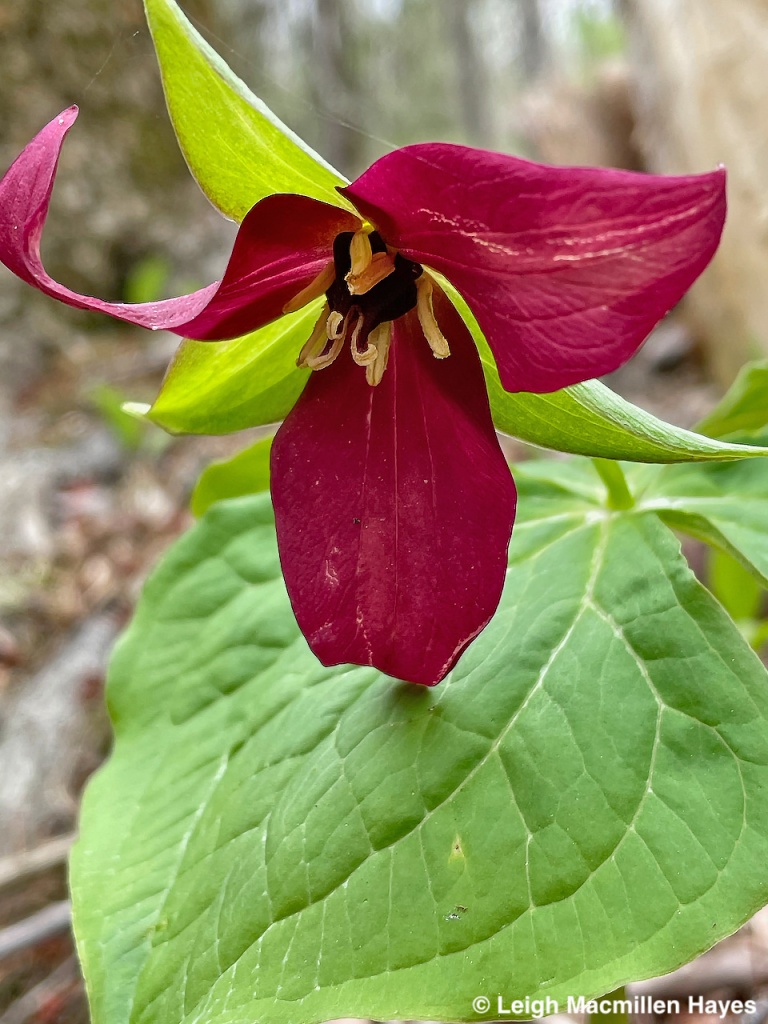
No gathering of flowers is complete without a touch of red, and though we found only one Red Trillium (aka Stinking Benjamin), it was enough for its rose-colored flower was well accented with egg-yolk yellow anthers.

Of course, we continued to find more Painted Trillium and no hike at this time of year is finished without my guy commenting on the trillion Trillium that I insist upon photographing. I assured him that I wouldn’t take pictures of each one today, but I surely would honor all of them and so as we continued and he somehow managed to walk by without noticing, I obnoxiously drew his attention to all.
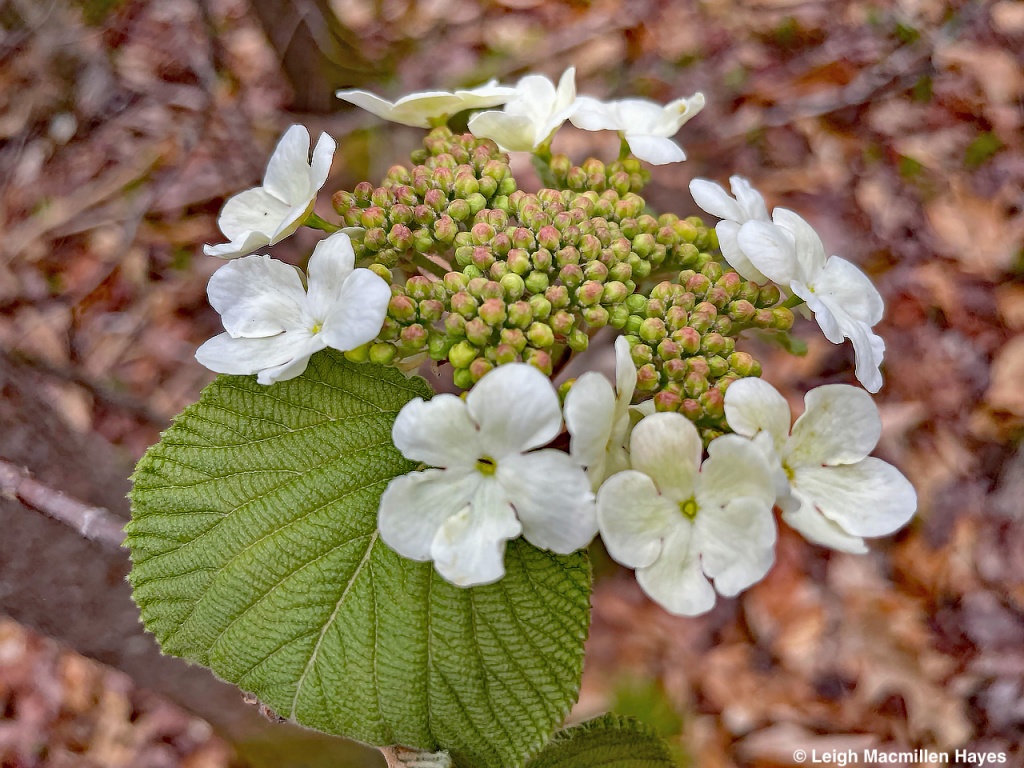
The one flower whose name he did learn today was Hobblebush. I swear I’ve introduced them before, and surely I have, but today the name and the floral display clicked–perhaps because they decorated so much of the trail we traveled, and truly, I’m not sure that I’ve ever seen so many in flower in one place.
The flat-topped clusters of flowers have a lacy effect and contrast well with the accordian-veined leaves. The outer ring of sterile flowers are said to attract pollinators who will then focus on the tiny fertile watermelon tourmaline flowers in the center. My wonder is this: do the sterile flowers have a second use–perhaps to keep others away because they find no nectar or pollen and think the plant isn’t worth a further exploration?
As I explained to my guy, the reason for the common name is its straggly branches that often bend and take root, tripping or “hobbling” passers-by.

To not include Trailing Arbutus would be remiss on my part, for so many were still blooming along the trail. And after I paused to photograph this one and then caught up with my guy and explained my focus moment, he was quick to quip that I was the one trailing! Always . . . in his hiking book.

By water’s edge, where we sat upon an overturned canoe to dine on our sandwiches, I found a few examples of Leather-leaf in flower, its tiny nodding, urn-shaped, pearly white bells with crisp rolled upper lips, on a short stalk hanging all in a row rather like a line of laundry on the clothesline.
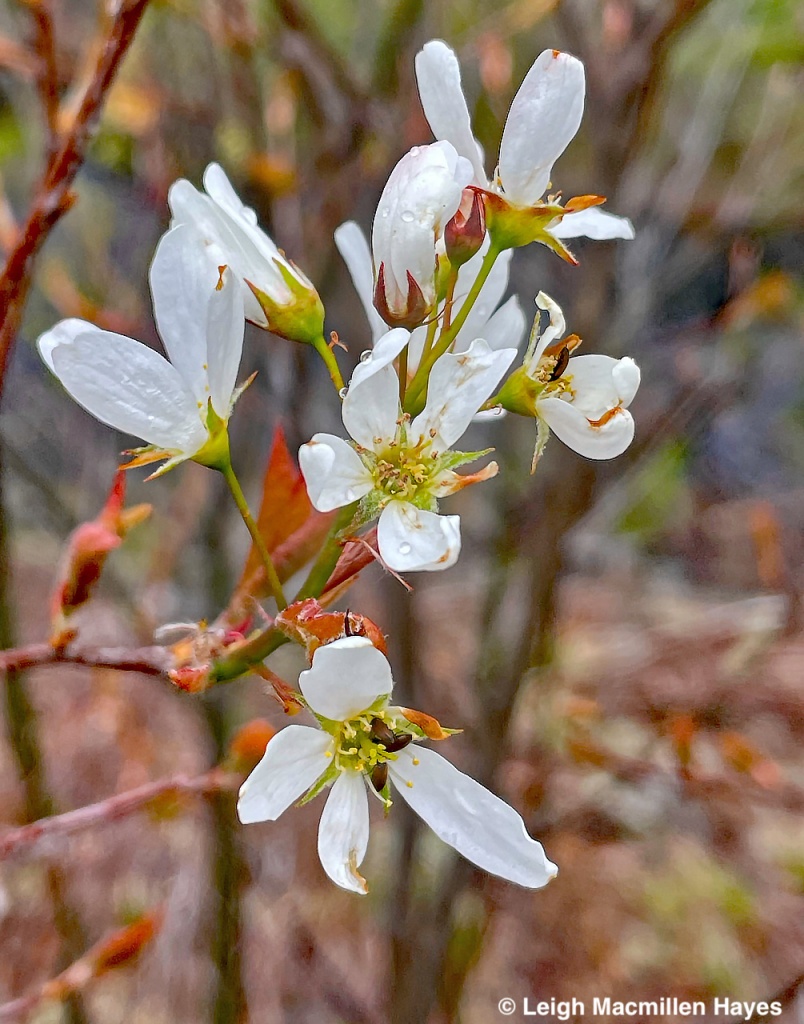
At the summit, it was Serviceberry, aka Shadbush, that announced its presence. Notice how the flowers have emerged before the leaves. Right now, mini-leaves are bronze-tinged, folded and half or less their mature size; eventually the leaves will become green and flat, with the upper surface smooth and the lower hairy just along the midrib but retaining a few hairs on the surface. Nothing like a bit of variation.
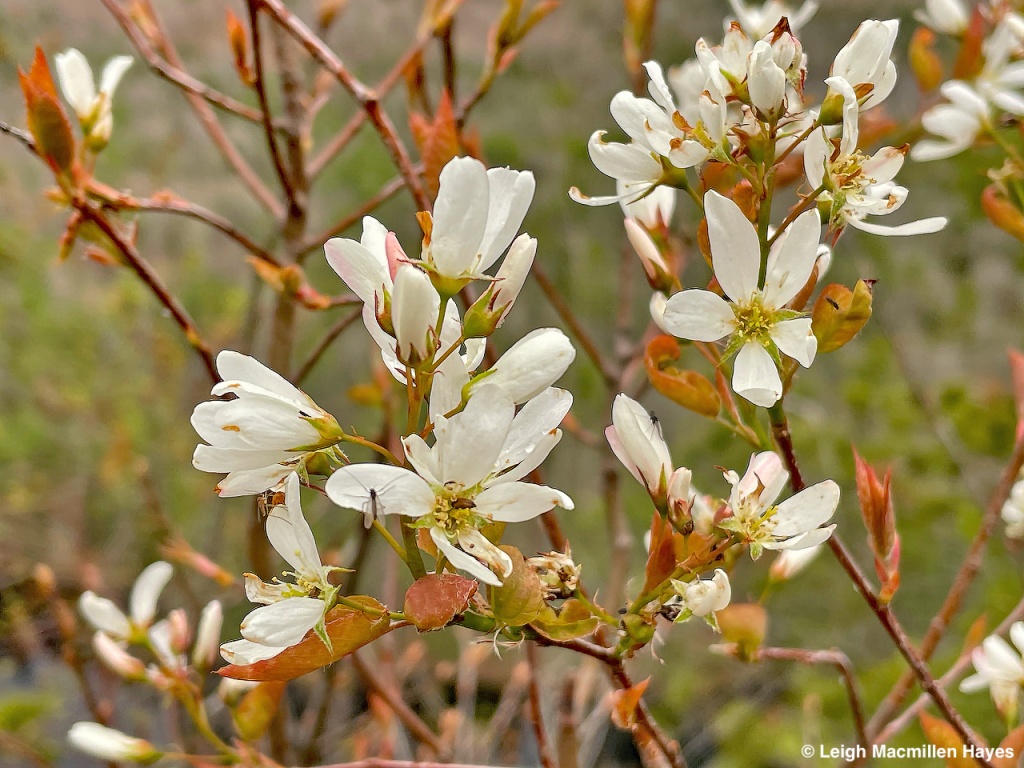
If you look closely, you’ll find at least one pollinator taking a pause as it was raining by this point in our hike, but another close gander may reveal a few others.
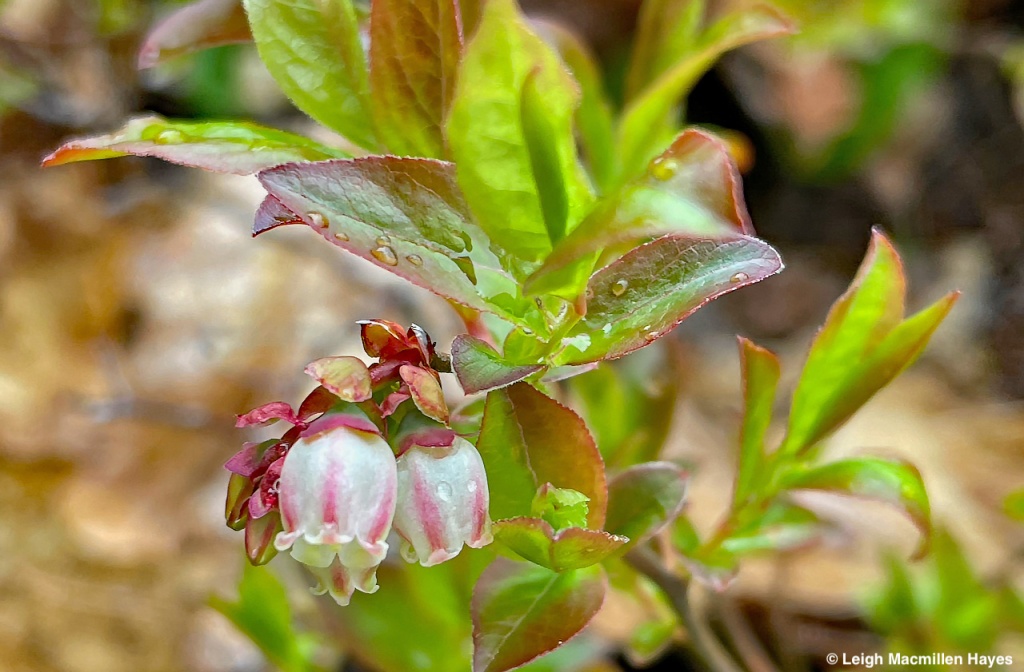
Again at the summit, and therefore closer to the sunlight that didn’t shine today, several urn-shaped white flowers with pinkish stripes, the petals fused and tips turned back, shouting that blueberry season is in the offing.
All of these we gathered in photographs as a bouquet to mark this Mondate.

There were a few other finds worth noting–like last year’s Lady’s Slipper capsule, the source of thousands of tiny seeds.
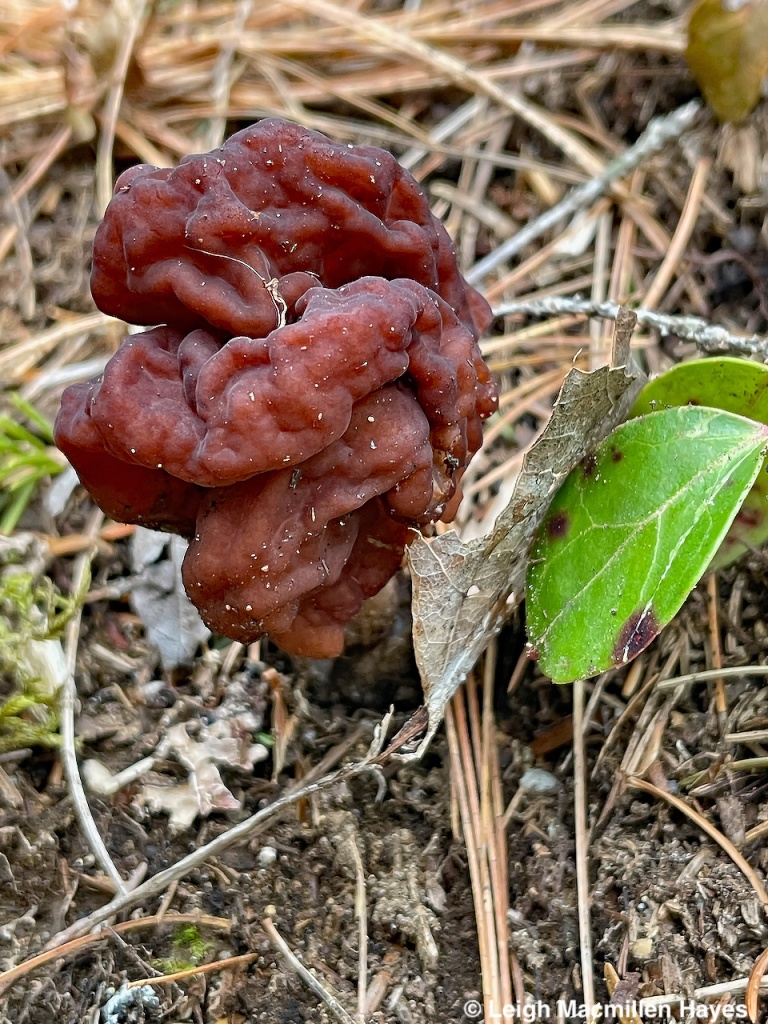
And the discovery of a few Morel mushrooms at the base of Northern Red Oak trees. That was another first find for me. I’m sure for my guy as well, though he hardly saw them 😉
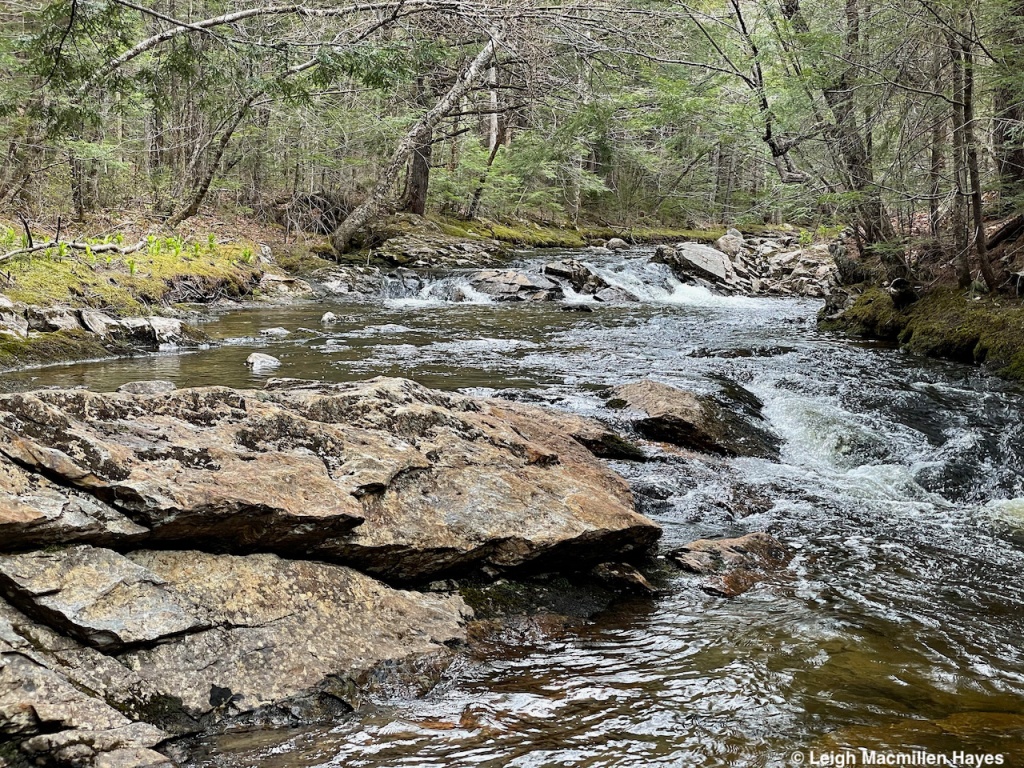
Our journey today found us hiking beside Sanborn River . . .
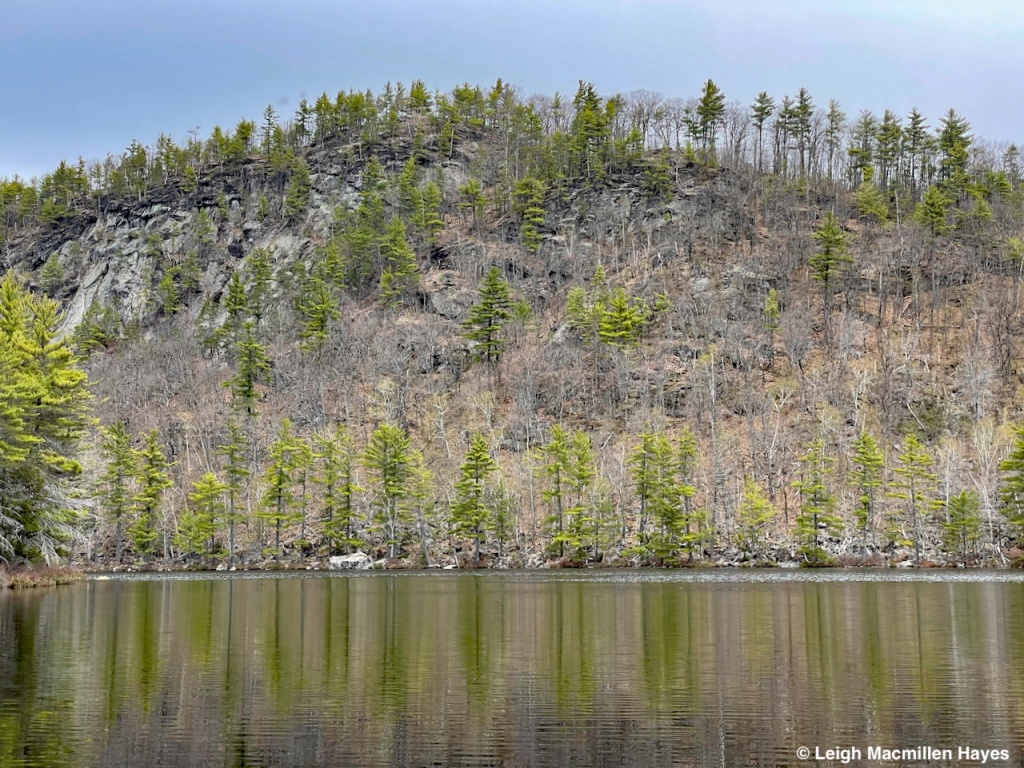
lunching on top of one of many overturned canoes beside Overset Pond . . .
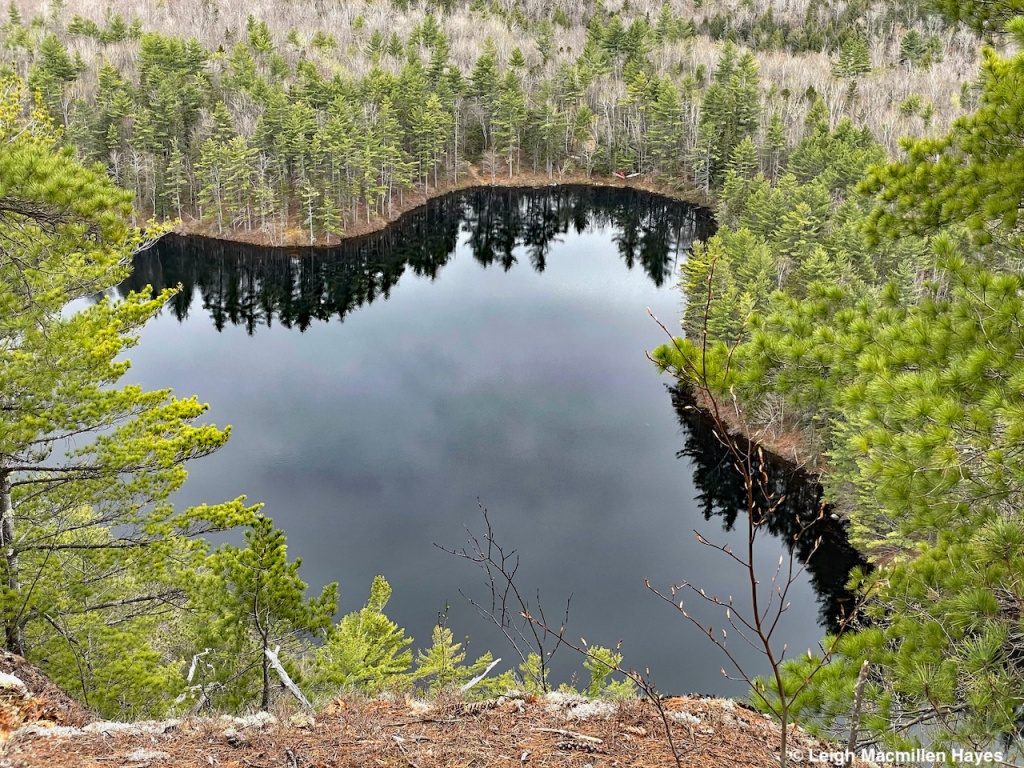
enjoying the mirror image of the pond from a false summit on the mountain . . .
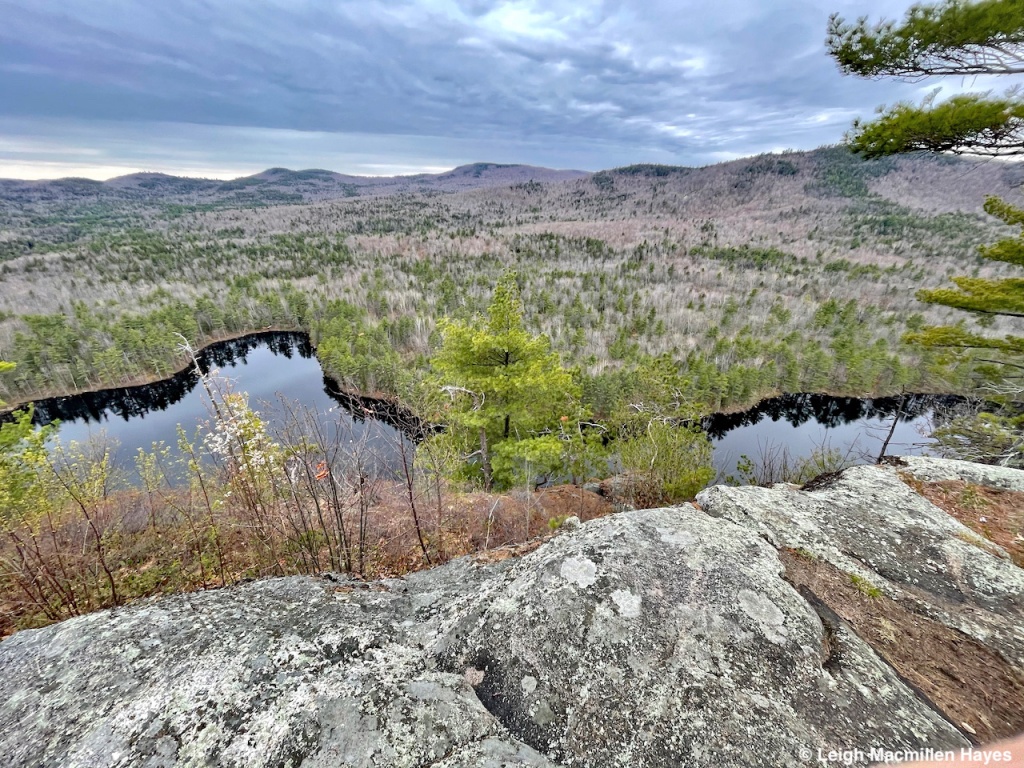
and taking in the entire scenario from the granite we stood upon to pond below, mountains beyond, and sky that reflected the ledge under our feet.
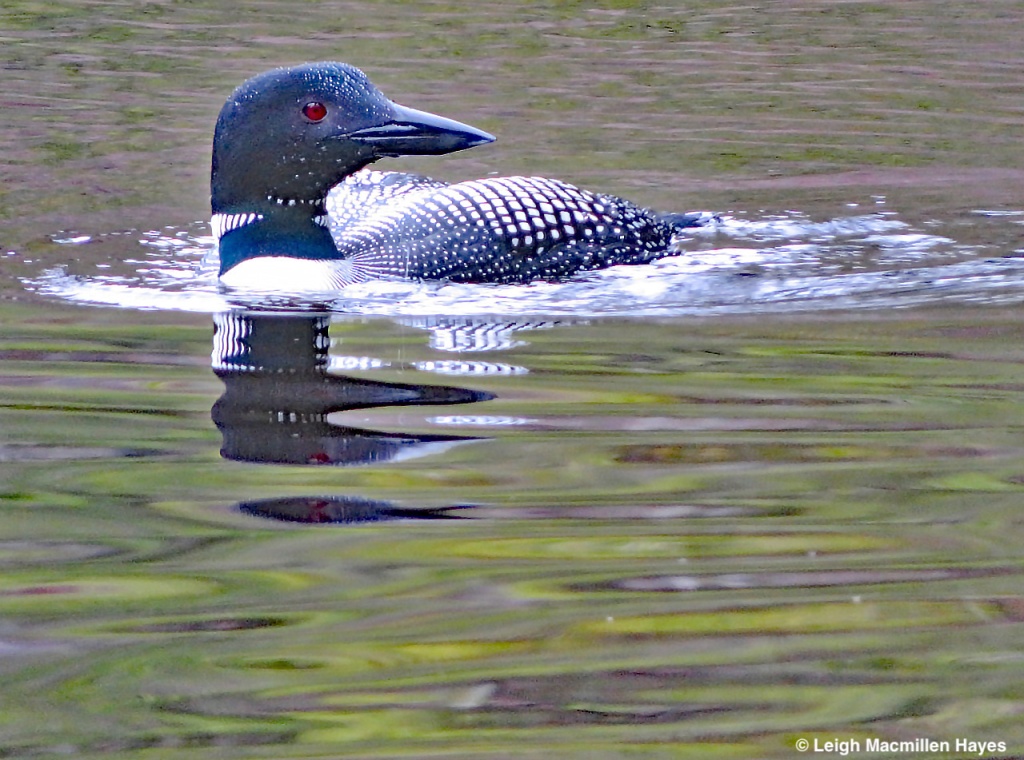
The flowers, the landscape, it was all worth the journey and we made plans to return in the near future. But the icing on the cake or pollen on the flowers was the pair of loons who entertained us from time to time in water so clear that we could see them swim underwater. Their re-emergence, however, was best and we enjoyed our time spent with them.
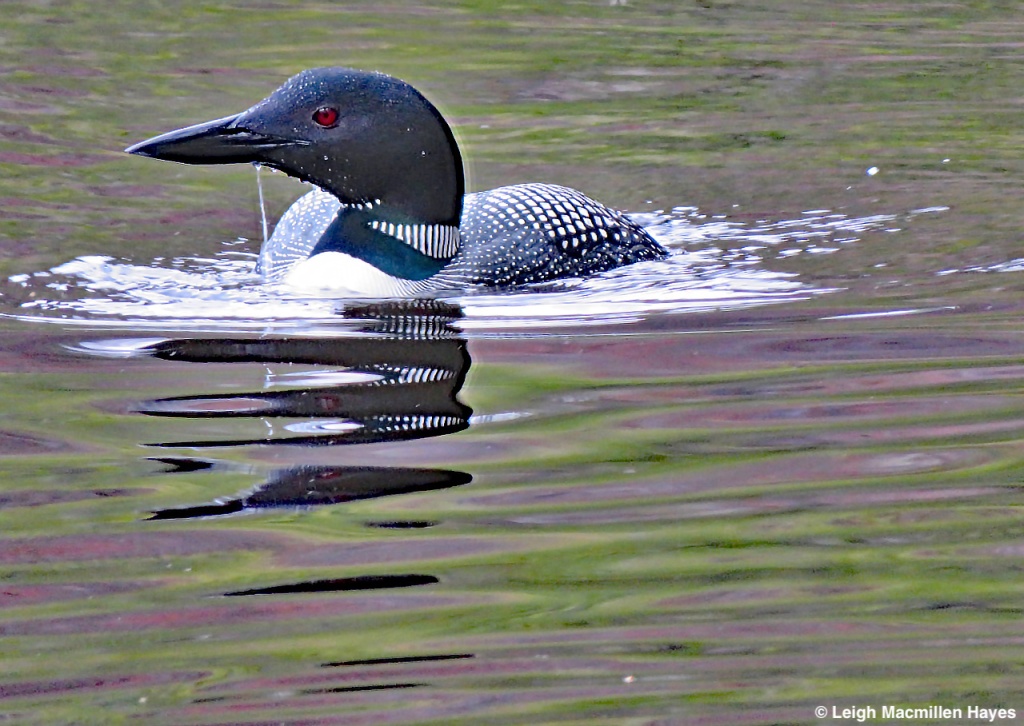
Overset Mountain and Sanborn River. A perennial favorite. A place to gather a bouquet without picking any flowers. A place to enjoy a variety of natural communities. A place to be native with the natives.
Thanks to Larry Stifler and Mary McFadden for allowing all of us to create an Overset Bouquet any day of the year.
Act One, Scene One.
Setting: The forest road, a two-mile walk from the closed gate.
Sound effects: Chickadees singing cheeseburger songs and White-throated Sparrows inquiring about Sam Peabody, Peabody, Peabody.

Props: Birch, maple and aspen trees leafing out.

Cast: Mourning Cloak butterflies in full mourning regalia.
Scene Two.
Setting: A bog.
Sound effects: Wind in the trees, a certain Grackle with a regular rusty-gate note; turtles plopping into water; Canada geese honking like bullfrogs.
Cast: Western Conifer Seed Bug upon a wooden wildlife blind.
Stage clothes: Dressed to the nines in a traditional afternoon ensemble.
Scene Three: Flowers of the bog.
Set decorations: Hobblebush in flower and featuring a crab spider in the wings.

Sessile-leaved Bellwort showcasing its flowerhead in a subtle manner.
The cast grows: one Painted Turtle.

Two Painted Turtles.
Four plus Painted Turtles.
Scene Four.
Setting; a tree snag.

Cast: a Grackle posing beside a potential nesting site.
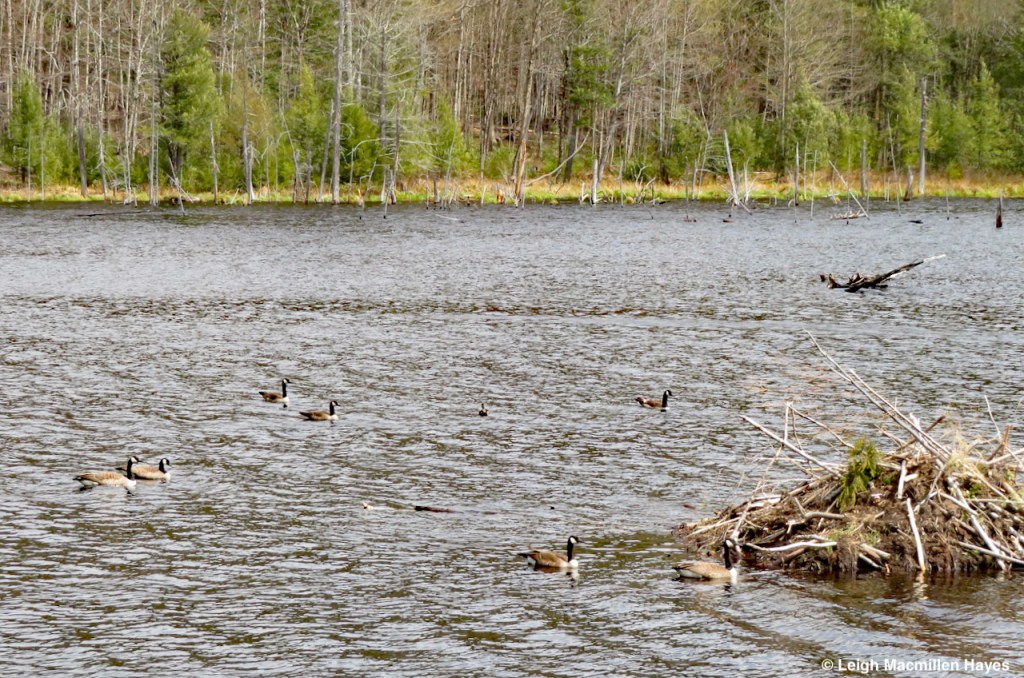
Cast: An American Wigeon located at twelve o’clock in the circle of Canada Geese.
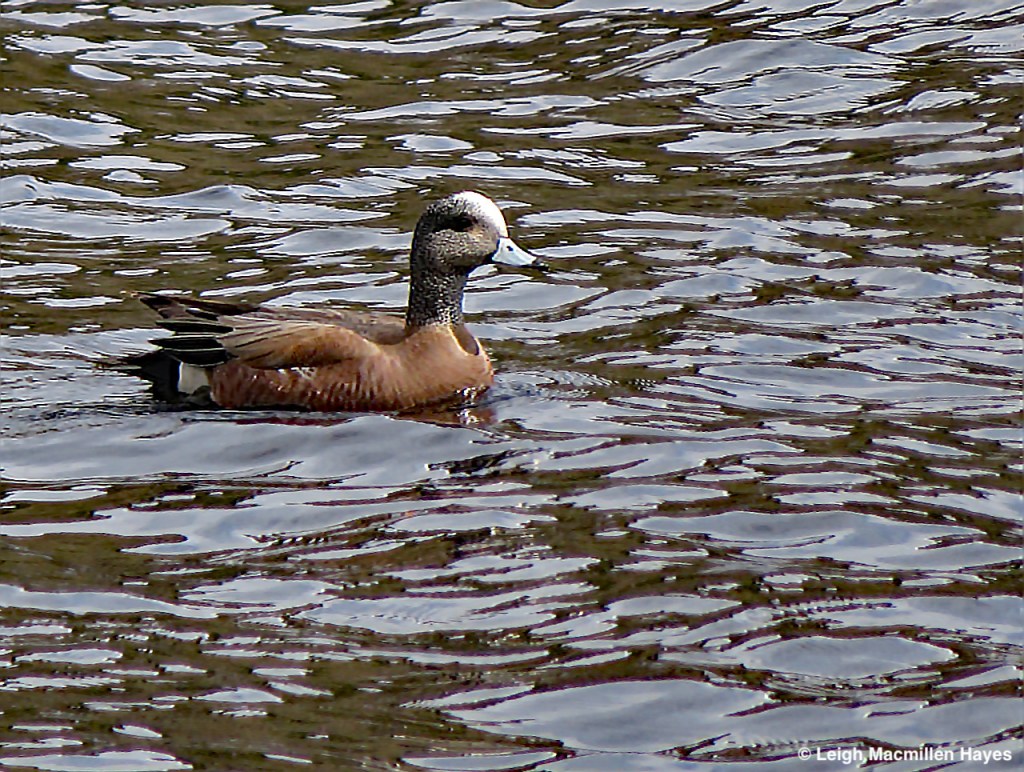
Main character: Female American Wigeon donning a warm brown body, grayish head with smudge around her eye, and pale bill tipped in black.

Supporting characters: Canada geese in preening mode.
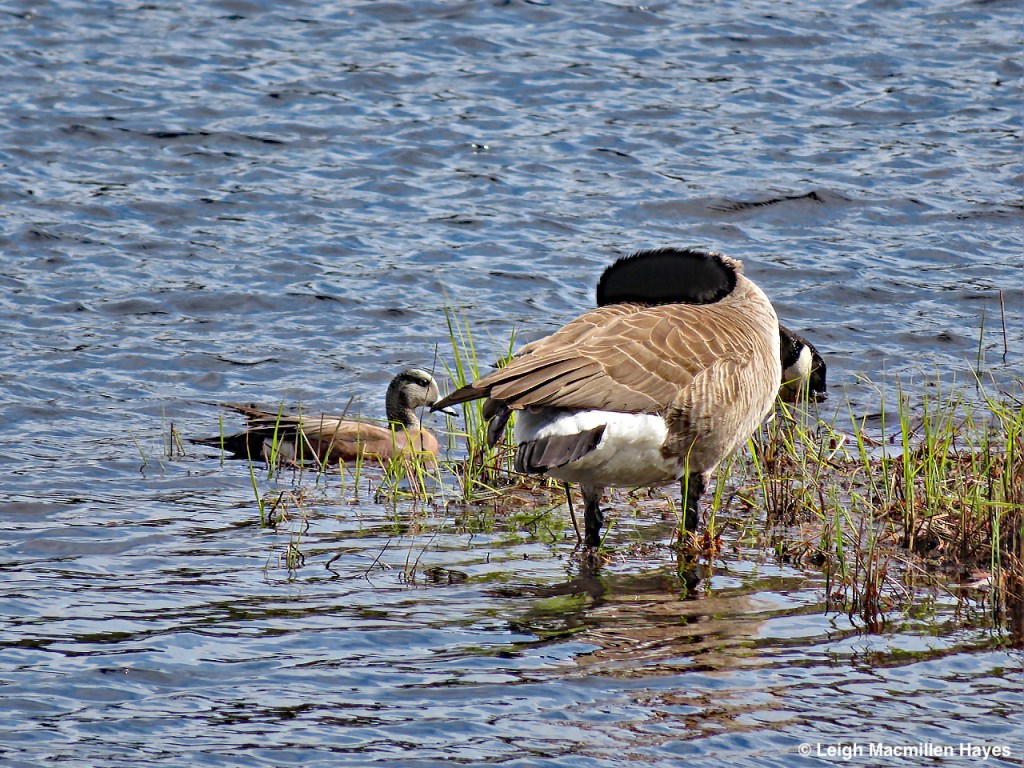
Action: The Wigeon swims back and forth as the geese preen.

Has perhaps the duck imprinted upon the geese?

She watches every movement as she munches upon the bog grasses.
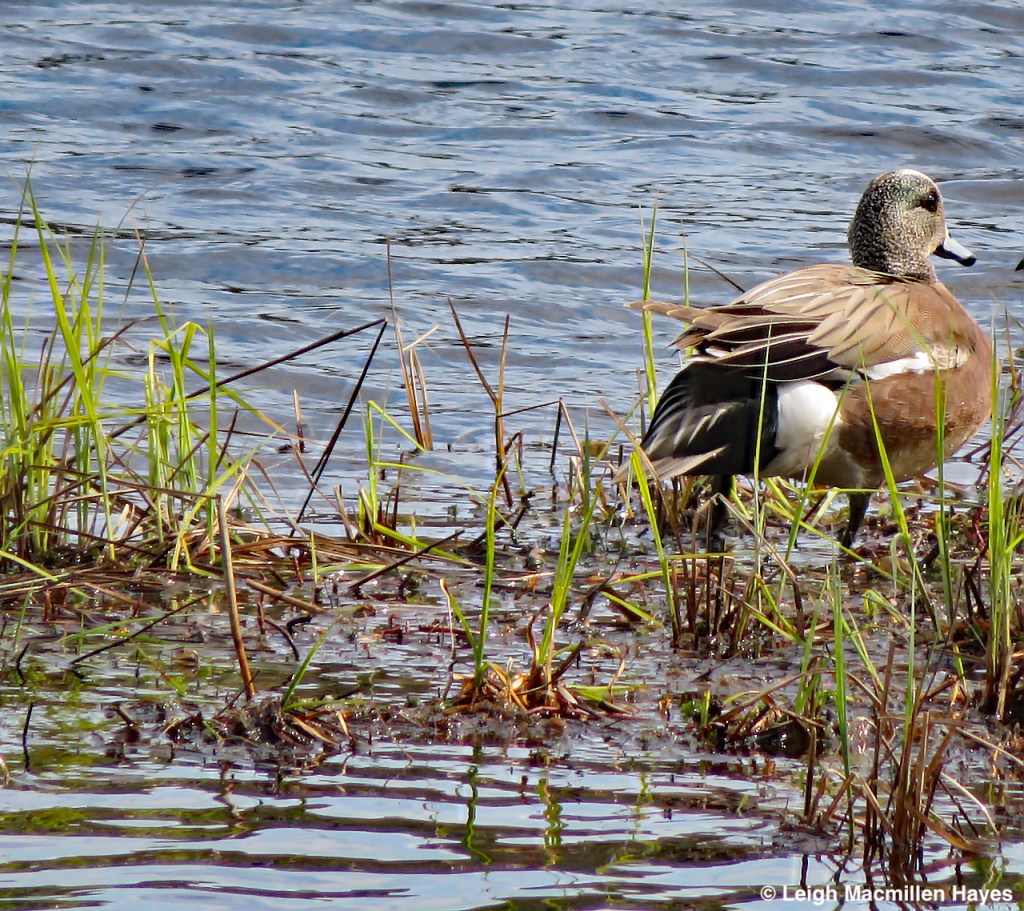
This is the second in one act plays dramatized at the bog where the Wigeon’s behavior is questioned by humans but hardly by the geese.
Stay tuned for the next one act play as life plays out at the bog.
Bridgton, Maine, was once a thriving mill town and Stevens Brook its source of power. My guy and I decided to once again visit the former mill sites of the Lakes Environmental Association’s Stevens Brook Trail, which meanders on and off road from the base of Highland Lake to Long Lake.

Jacob Stevens, for whom the brook was named, was a ranking member of the survey crew that came to what is now called Bridgton in 1766 from Andover, Massachusetts. He returned in 1768 under contract with the Proprietors to develop water power and make it serve the early settlers by creating mills that provided building materials and grain for food. He identified twelve power sites along the almost two-mile brook with a drop of 156 feet from its source at Highland Lake (known originally as Crotched Pond) to its outlet at Long Lake (Long Pond). The first mills were used to provide building materials and grains for food. And the first dams were made of boulders and gravel with heavy timbers. Bridgton was all forest land when Stevens arrived.

Of course, Highland Road did not exist in Stevens’ day. Nor did any of these structures. In fact, the water extended across where the current road is located. And it wasn’t as big a lake as it is now for the dam, built in 1849-50, changed everything. It had a different configuration and lower depth as it was mainly a pasture and wetland. This photo was taken from the bridge. The first bridge was built in 1808.

Across Highland Road, which had been called Water Street when it was first built, is where the pond extended to previously.
His first mill was about where Power Site #10 is located near the mouth of the brook closer to Long Lake.
But, the market was limited. There were many obstacles including a lack of roads. Sawn lumber rotted before he could transport it to remote areas of town. Eventually he moved it north to the outlet of Highland Lake.
He was also required to keep a grist mill operating for 20 years, which he did near the 11th power site. That did much better.
In exchange, Stevens received land and the rights to the waterway.
Eventually, his term passed and others purchased water rights.
Power Site #1 next served as Asa Kimball’s saw mill, which he built in 1788. This is the mill pond as we see it today, but just imagine what it may have looked like before the road was built. Crotched Pond served as Mr. Kimball’s mill pond, where he floated logs from Sweden (Sweden, Maine, that is). Presumably he built some sort of dam where the present one is by the beach to create a more definitive mill pond.

The split stone dam was erected in 1858 by Rufus Gibbs and others, thus providing power for the first big mill in the village that stood four stories tall, employed 50 workers, ran 20 looms and made blankets for the Civil War. By 1941, is was demolished.
The mill had various names over the years including Gibbs Mill, Upper Mill, Little Mill, Little Pondicherry Mill, and Cumberland Mill.

Though my guy and I looked at and talked about Power Site #2, I neglected to photograph it. Anyway, it served as a grist mill in 1798.
Between 1835-1845, Rufus Gibbs established Window Sashes and Blinds Mill. In 1871, Jesse Murphy purchased it and continued to manufacture the same. The machinery was run by a mill wheel, but the demands for power were such that it was eventually electrified.
In 1912, the Saunders Mill was constructed in this place, the remains of which still stand.
Traveling downstream, Power Site #3 sits between what is now Oberg Insurance (built as a bank and then served as courthouse and police station) and the Hayeses’ buildings, that currently house the Bridgton News and Gallery 302.
There was once a large mill pond here.
Power Site #3 had a storied past: 1813-fulling mill (put weaving in hot water and beat it to clean and thicken fiber); 1822-saw and grist mill; 1830-saw, grist and plaster mill; 1845-mill burned; 1857-rebuilt two stories; 1877-never rebuilt. Yet this was long known as the Dam Site and a Dam Site Restaurant stood here for years. Across the street was a tannery, which didn’t need water for power, but did need water to fill the 140 vats. Using hemlock bark, 10,000 hides were tanned each year.

As I mentioned, the trail winds through the woods and over roadways, but also under the Bob Dunning Memorial Bridge, the gateway to Pondicherry Park. If you are following the Stevens Brook Trail, however, you’ll pass under the bridge and it’s worth a look upward–for you just might spot three American Robin nests all in a row.
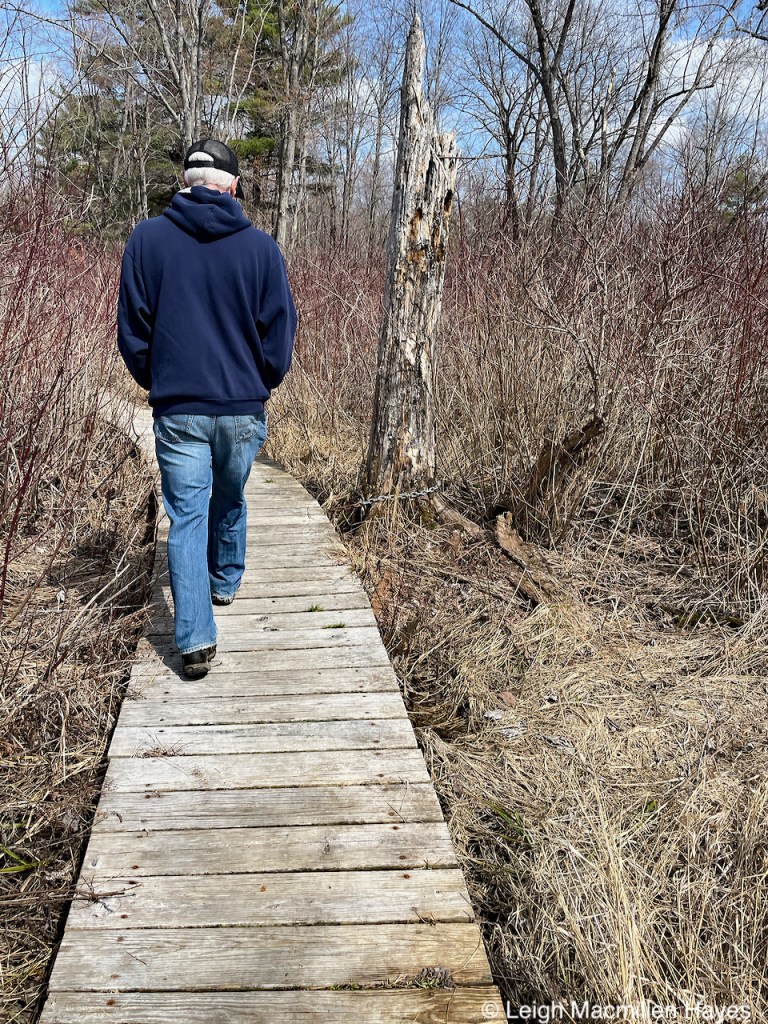
It’s in this area that hikers follow a boardwalk through an area that can be quite wet at times.

It is here that Willet Brook joins forces with Stevens Brook, thus increasing the power of the water.

The power of others who grow beside the brook is displayed like daylight fireworks, that being the male Red Maple flowers–their anthers yellow with pollen awaiting dispersal.
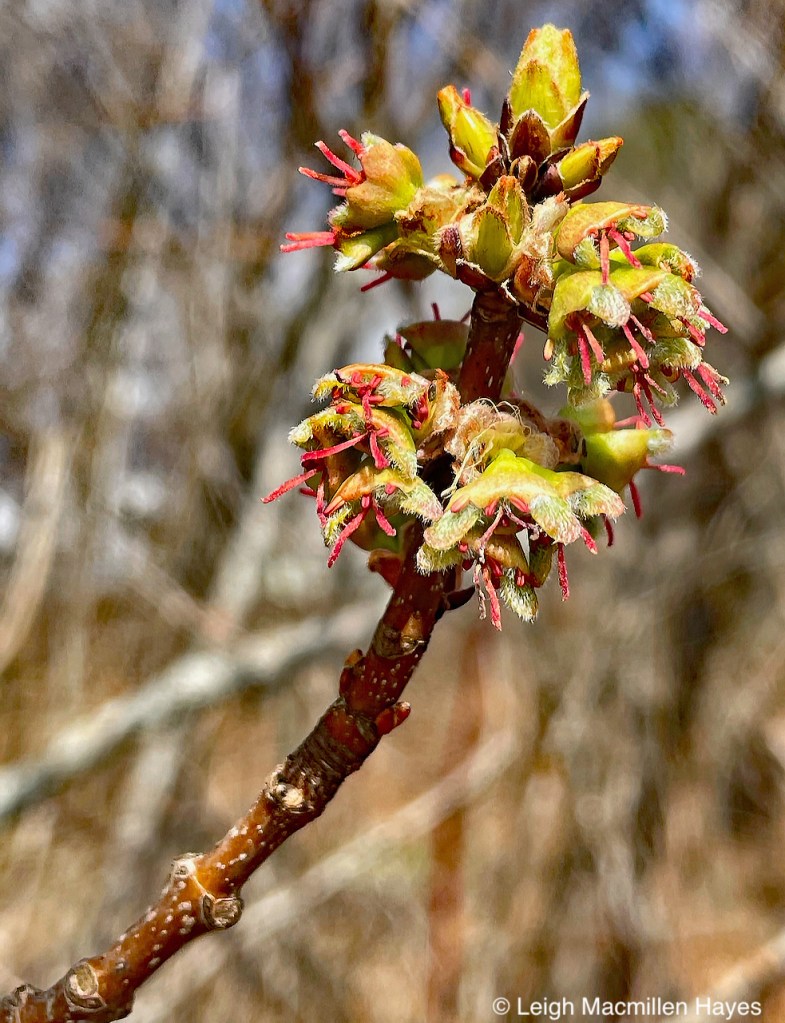
And close by, the female counterpart, her pistils divided like vees perhaps signaling victories to come.
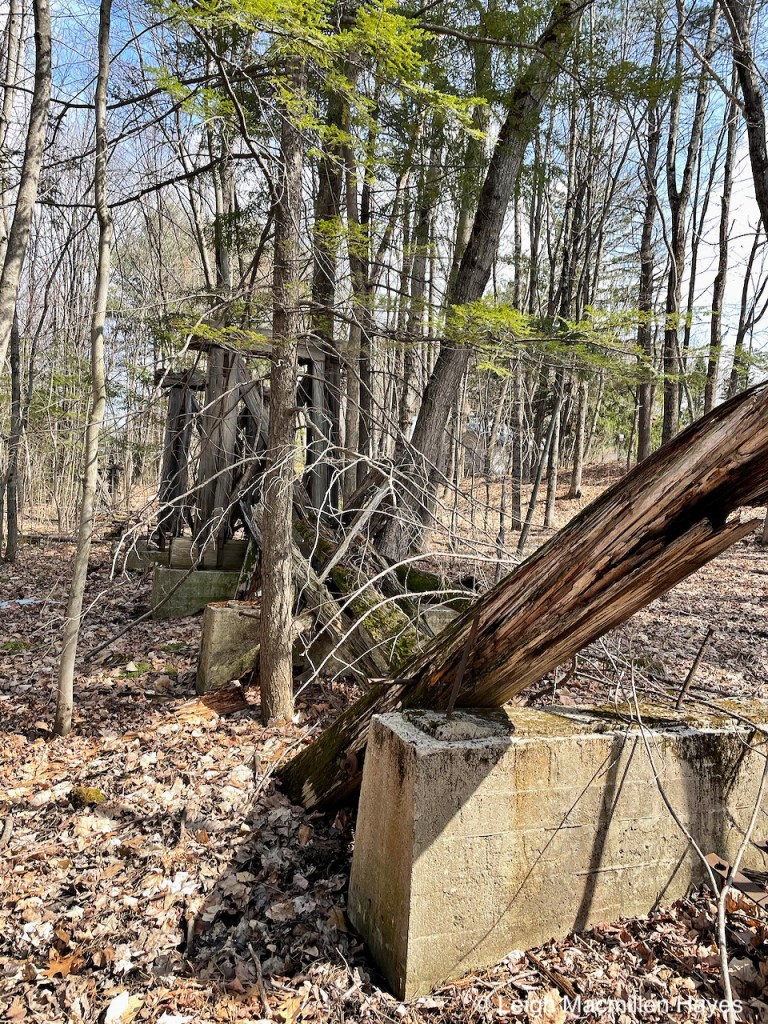
A zig and a zag, and a stopped truck allowing us to cross the main drag (thanks Brian Fox), and soon we found our way along the former route of the Narrow Gauge train track. It’s located by Power Site #4.
In 1822, this area of town wasn’t part of the main village–that was confined to Main Hill. A water-powered carding mill equipped to prepare wool for spinning, thus replacing the tedious hand work of disentangling, cleaning and intermixing the fibers was in operation just across the brook at the time, now the home of Food City Grocery Store.
By 1825, James Flint and Aaron Littlefield built a sawmill, which they operated for 15 years. In 1840, this was the site of the Walker Saw Mill and Grist Mill. And then things changed.

The Pondicherry Mill was built in 1865 to manufacture woolen goods. It was one of the most extensive manufacturing plants in Maine at that time and employed 50 operators.
In 1898, the neighboring town of Harrison wanted to be connected via the railroad and the railroad owners obliged. From this spur, a trestle was built that carried coal in dump carts to the Pondicherry Mill. It appears that the trestle came in backwards off the rail track and perhaps the coal was located in the back cars, ready to be unloaded into the carts. The trestle structure has deteriorated immensely, but still stands as a monument to this moment in history.
So wait, think about this coal situation. The mill had grown to employ 225 people and water power from the brook was no longer dependable. An immense coal-burning chimney about 100 feet in height had been added to the mill. Sixty looms produced 18,000 yards of cloth weekly. Though the building stood until the mid-sixties, the industry moved south long before that. The stones by the brook and trestle are all that are left to tell the story. A now-deceased resident, Reg Fadden, used to tell the story of knowing what color they were dying the wool on any particular day–he’d see the color in the water as he walked to school.


The first mill to be located here was a sawmill built in 1868. By 1871, a shovel factory was built on the west side, which was the side we stood upon. By 1899, the Bridgton Lumber Company had located to this power site, with two mills operating–one for boxes and house furnishings; the other for lumber. Boxes were needed for the corn industry, as a Corn Shop flourished on nearby Depot Street, close to the train terminal.

This apparently was a successful site because in 1911 it became the Burnham and Newcomb Sawmill, which was purchased by Harry Bisbee in 1920. He used a turbine since the water power wasn’t dependable. Though it gushed over the rocks today, in the summertime, this is the perfect place to sit on the flat rocks and dangle ones feet.
Apparently there was a treacherous footwalk that crossed the brook in this area and even at age 90, Mr Bisbee would walk across. The sawmill eventually burned, with only the office remaining. This time, using a diesel engine, Mr. Bisbee started a smaller sawmill. In 1953, the dam washed out with a flood and local lore has it that Mr. Bisbee walked out one day, leaving it all behind. He died a couple of years later, gifting the mill to the public library.
Charles Fadden and his son, Reg, bought the mill at auction and operated a box mill, using a turbine for power. The office was still standing until about ten years ago, when it collapsed.
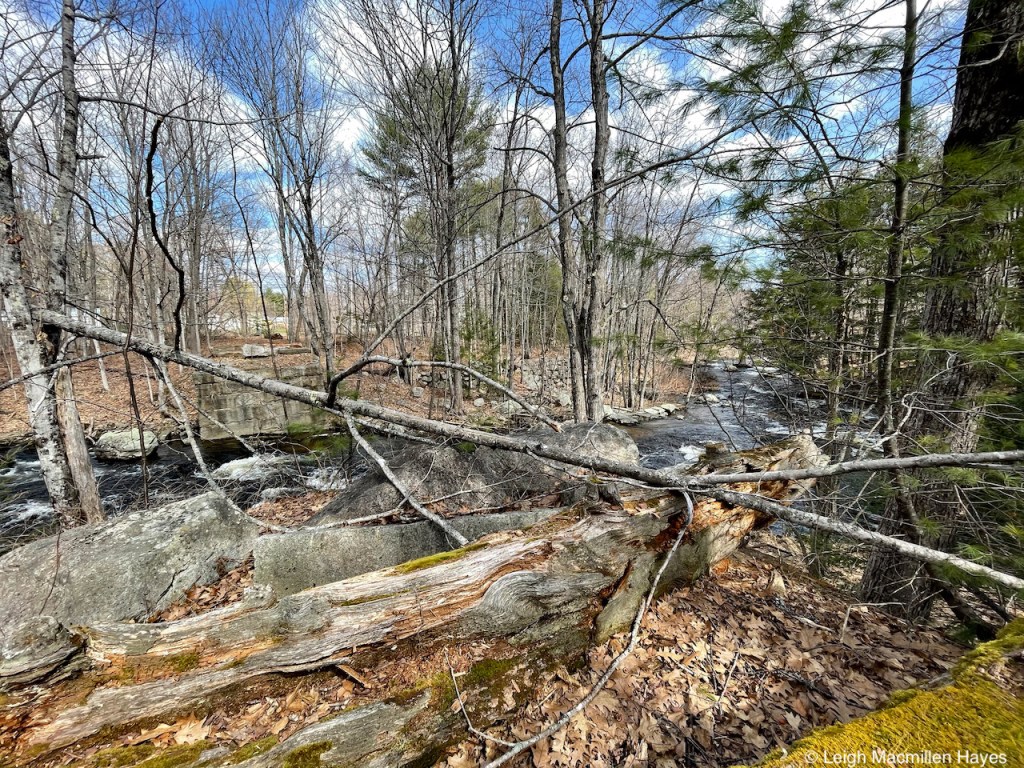
By the mill, the Harrison Narrow Gauge crossed over a trestle; today only the stone stanchions remain.

This image courtesy of Bridgton Historical Society provides a bit of a sense of the scene in the day.

It was here that I recognized a tree I don’t always encounter–a black locust (Robinia pseudoacacia). The bark appears almost braided and the overall essence that of a child’s fairy tale tree.

Power Site #6, better known as Lower Johnson Falls, was the possible 1859 site of the Milliken Bedstead Factory.
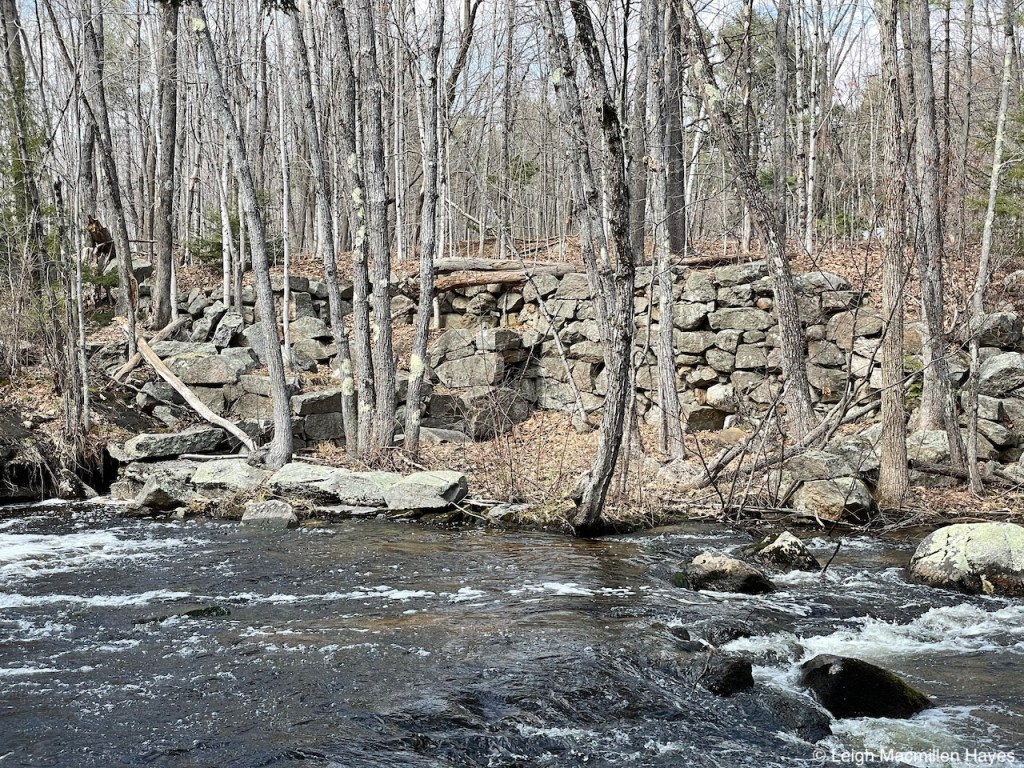
A foundation is still visible on the eastern side of the brook. It’s in that area that there is also evidence of the Walker Sluiceway, one that dodged all the dams so logs could travel from Crotched Pond (Highland Lake) to Long Pond (Long Lake) without impediment.

Beside Power Site #7, still stands the building that housed the coffin shop. Hey, somebody had to build them. Lewis Smith built the two-story building with a basement in the late 1860s. It was a sash and blind factory, but he also built furniture, and yes, coffins. More local lore: he was the town’s first undertaker. While the building has had several owners since then who have tried to restore it, it still needs some (way more than some) tender loving care so it doesn’t go the way of all the other mills.
If you peer closely, you might see all that remains of a water-powered turbine on the building. From the left, it’s located under the third window of the second floor. Originally, all the water wheels along the brook were overshot wheels. While an overshot wheel had horizontal axils, a turbine wheel had vertical axils, thus making it smaller, more efficient and more dependable given the rise and fall of the water.
What’s not pictured is the western side of the brook, where a Foundry and Bridgton Machine Shop were located.

And on the front lawn of the coffin shop, the real deal–a Perry Turbine Water Wheel. In 1877, Richard Bailey and Samuel Miller operated an iron factory and machine shop built by William Perry and George Taylor across the road from the Smith factory. When they sold their business to Forest Mills owed by William Fessenden Perry, it was renamed the Bridgton Machine Company with George and Frank Burnham taking over as managers.
Overshot water wheels had a horizontal axis. Nearly all the water wheels of the early mills were overshot wheels, best adapted for small streams with high falls. The overshot wheels didn’t hold up long over time and were replaced a century later by the more dependable turbine water wheel. A turbine had many benefits including a vertical axis; small in bulk for its power, efficient in highest and lowest falls, and more dependable. In 1887, the Perry turbine was invented at the foundry and it received nation-wide popularity for use in mills along small streams.

Power Site #8 is one of my favorites. This is where Perry and Taylor erected a mill in 1862 to manufacture woolen goods. The dam was built to provide a fifteen-foot fall with a mill pond above.

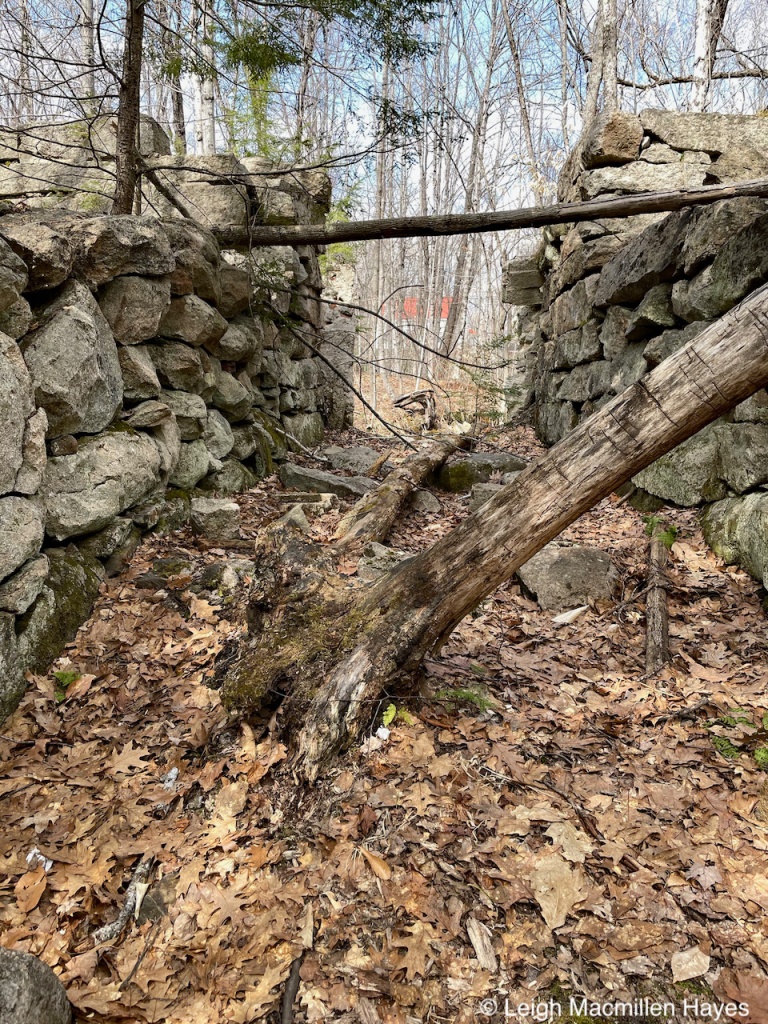
Today the sluiceway is dry, but I can imagine the water pouring through here.

With the advent of Kansas Road in 1865, the woolen mill expanded to 200 feet by 45 feet and stood two stories tall. With more looms than any mill in the area, outerwear was produced here and shipped to Boston. During the Civil War, attention turned to creating war materials.

Anyway, Taylor and Perry purchased this site in 1865 and built a three-story carding mill with an overhead walkway that crossed Kansas Road and connected their two mills: Forest Mill #1 and Forest Mill #2. By 1879, Mr. Taylor had died and Mr. Perry re-organized as the Forest Mills Company, which employed 130 workers and produced cashmere. As the late Sue Black had told me, this was not from cashmere goats but rather a lightweight fabric consisting of wool fiber that had either a plain or twill.

A railroad spur and trestle were built in 1900 to unload coal and other supplies for the Forest Mills Company.

The American Wool Company purchased the mill, which was large for Bridgton, but small compared to those south of Maine. Eventually, business moved south. In 1925, a shoe shop moved in, but it wasn’t successful either. The building was torn down in 1962.

Our journey today found us following the trail for the most part, but there was some bushwhacking as well, which opened our eyes to more mill pond and artifacts.

One such was a truck my guy surmised to be of 1940s vintage.

We also discovered an old lodge that might be considered a McBeaver lodge, for such was its size.

At last we reached Power Site #10. This is the most modern of them all, but again, it has a history. It’s possible that this was the site of Jacob Stevens’s first sawmill built in 1768.

Mr. Stevens would have built a boulder and gravel dam, not one of cement certainly. He lived nearby and raised eight children; the four oldest worked beside him. It made sense for him to build a site here for both a saw mill and grist mill, as this is near the mouth of the stream and would have provided him with easy access to the main thoroughfare of Long Pond and beyond.
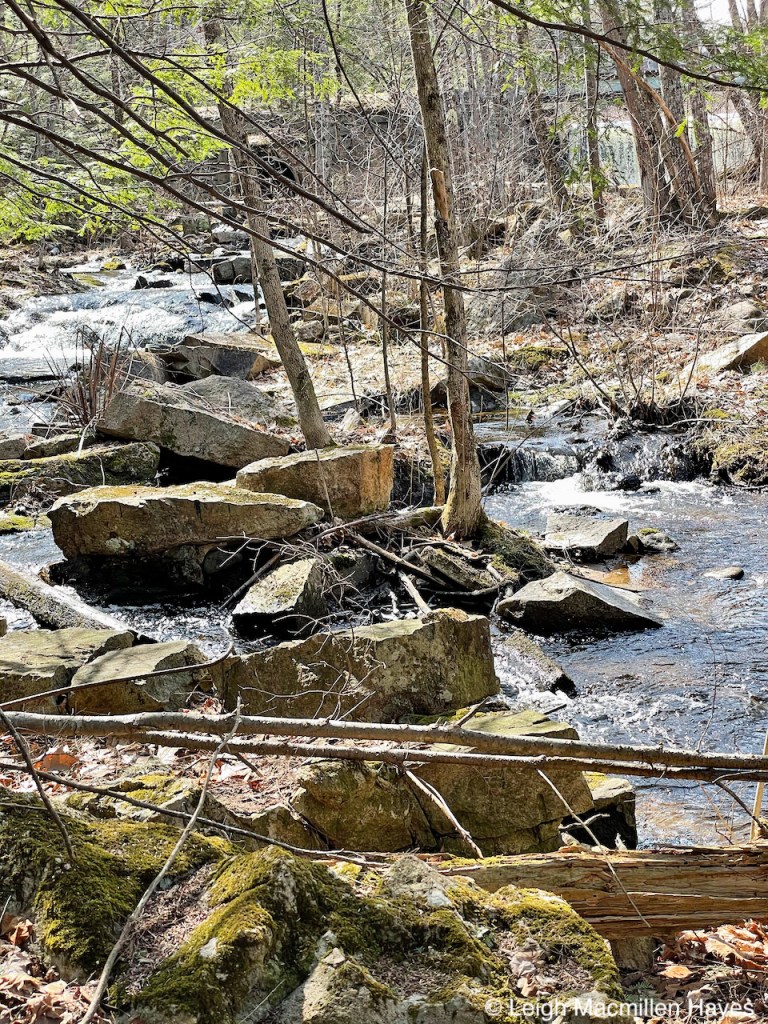
I don’t know what happened between 1768 and 1896 when the Bridgton Water and Electric Company took over as the first source of electricity and water for the village.

The concrete dam was built in 1931 by Central Maine Power after several transfers of ownership.
A 790-foot penstock was built to regulate the flow of the water. If you look closely toward the left of the dam, you might see the round hole that was the start of the penstock.

The greatest power could be found between this site and Power Site #11, where the brook drops 25-30 feet. The Hart Tannery may have been built on an island in the middle of the brook somewhere in this vicinity.

The exact location of Power Site #12 is also elusive, but rumor has it that a shingle factory was located between Site #11 and the outlet. Look closely and you’ll see the water racing southward, Long Lake through the trees on the left, my guy through the trees right-middle, and the present day power station.

Each time we reach this spot, I have to wonder what Jacob Stevens or those who came before him would think of our energy consumption.

Early on, a wooden structure was used as a power house. That was replaced by a brick building built in 1922 by the Western Maine Power Company. Notice where the penstock entered. And above it, a turbine generator.

At last we reached the mouth of the brook, where the water seemed extremely low for early spring, but served as a reminder of why the turbine was built to replace the water wheel as a power source.
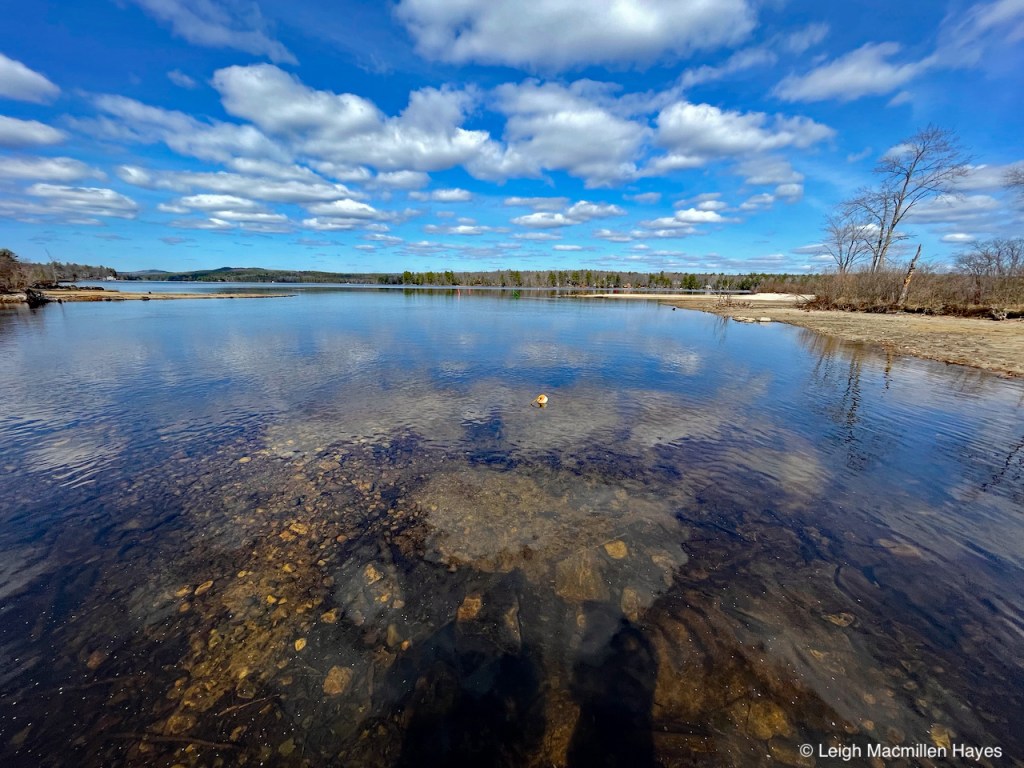
Upon reaching Long Lake, we’d finished our journey. Well, sorta. We still had to walk all the way back 😉
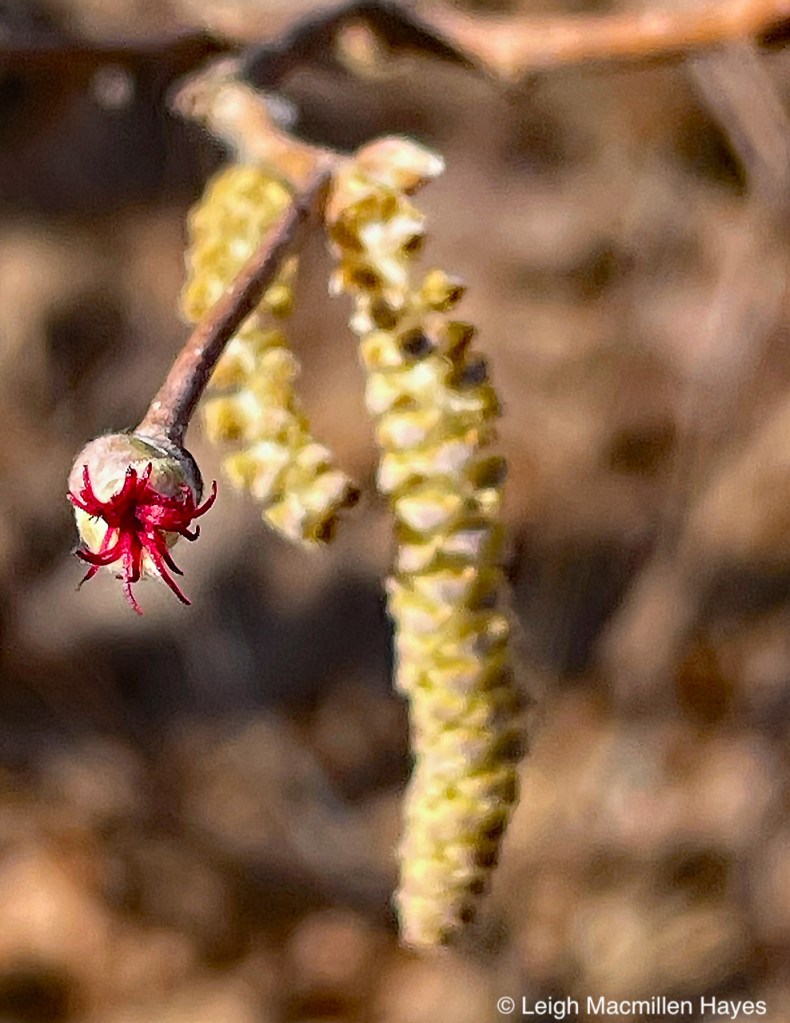
But first, there were two more things to admire. The minute magenta flowers of Beaked Hazelnut are so easy to overlook that I feel I must honor each one I spot. And hope you’ll do the same.

And then there was the Song Sparrow who reminded me that there were a few people to thank for this “Long” Lake journey: not only Jacob Stevens and all who came before and after him; but also the late Sue Black, fiber artist and historian who shared the trail many times with me; Ned Allen, former executive director of Bridgton Historical Society who let me pick his brain and comb through files upon many occasions and use photographs within those files; and all of you readers who stuck with me for such a long read.
The word went out last night: “Trails aren’t perfect but much better than they were! We need a few people to snowshoe Moose Alley so I can get the snowmobile up there. Jim is going to snowshoe some tomorrow and the more it is packed down the sooner I can groom up there. 😁 Both bridges are done. Still waiting on the snow roller.”
Nothing like a challenge and so I immediately contacted a few peeps and asked if they were in. They didn’t hesitate and we agreed to meet at the trailhead at 11am. After all, our services were needed.
We’d first explored this property a year ago and fell in love immediately and have returned once or twice since, but not at all in the last six or seven months. Therefore . . . it was about time. Ah, but what is time?
It took us at least a half hour to move beyond the farmhouse, for every three feet we needed to stop and chat–asking each other questions and offering suggestions about a Bugs in Winter course we’re enrolled in and trying to better understand.
But . . . another reason for loving winter soon presented itself, first in the form of snowshoe hare prints, the toes actually showing in present snow conditions.
The print left behind by a mature White-tailed Deer measures about two inches across, while a Moose print is about 4.5 inches. This one at three inches, with a deep depth in the snow, spoke to us as a youngster of the latter.
And right behind that a bed. A Moose bed. The smooth, rounded edge indicated the mammal’s back, with its legs folded below (left side of the photo) and head just left of the beech sapling.
Scat and urine presented themselves in a variety of spots including filling individual prints.
As we followed the track, we noticed another design in the snow that took a moment to interpret for it didn’t present a pattern that bespoke a bird or mammal.
Examining the Red Maple sapling that dangled over the design in the snow, however, solved the mystery–and we chuckled as the story began to make sense. In the act of dining on fresh buds, the Moose broke the branch, which consequently dangled below, and wrote its own story in the snow.
Slipping further off trail, (sorry Becky, but we couldn’t resist) Moose tracks led to another bed and we realized by its size and the size of related prints, that this was a bigger animal. Mama perhaps? Again, we could see how she bedded down, her legs tucked under as is the typical fashion.
A bit further on and another, deeper Moose track. Notice how far down the animal’s foot sank in comparison to my snowshoe. Yikes.
A tramp through the woods and we found the bed of a larger Moose. Actually, there were two in this area, and maybe we missed a third, but the point is that there’s an active clan in these woods and our hearts rejoiced.
Finding a scat-filled print shaped like a heart certainly added to our joy and brought more chuckles in the midst of admiration and awe.
Suddenly, though there was nothing sudden about it for it took us about 2.5 hours to reach this point, we found ourselves standing beside Moose Bog–and scanned the landscape for an anomaly, hoping beyond hope that we might spot a family member seeking sun. That wasn’t to be.
Despite the lack of an actual sighting of a Moose, we were tickled to know that we snowshoed in their recent presence and so we posed and said, “Cheese.” Can you see our smiles?
In the same spot we looked for a species we first encountered in this very area last year. And found it upon the very same structures–a Speckled Alder and American Beech. It’s a sooty mold known scientifically as Scorias spongiosa or, my favorite and drum roll please . . . Beech Aphid Poop-Eater: A fungus that consumes the scat (frass in insect terms) of a Beech Blight Aphid (not the same as Beech Scale Insect that causes Beech Bark Disease). We’ve more to learn, but were regaled with the opportunity to spot it in the same spots again.
Our insect hunt included a Winter Firefly, some Pine Sawfly Cocoons, these former Gypsy Moth pupating cases and a few unknowns.
This tiny cocoon attached to two pine needles was one such find. With further study I trust we’ll confidently be able to state its name and origin. Lots of further study. We have so much to learn and appreciate the ability to notice, bounce questions off each other, and wonder.
There’s so much to wonder about . . . and to think we’d only explored one trail in the midst of many. When we began our exploration at 11am, I told Pam and Pam (aka Pam Square) that I needed to hit the road by 4pm in order to take a phone call at 5. Exactly five hours later we made our way. back to the trailhead. And as you can see, the sun was heading over the hills.

At last, back to the farm we were, home of among others, two Norwegian Fjord horses named Marta and Kristoff blankety, blank, blank, he being the younger of the two.

Marta looked a bit bored with us and ready to fall asleep. We noted her trimmed bangs and longer mane.

Young Kristoff was more ready to pose, his bangs longer than groomed mane.

He seemed to understand our adventure–sticking his tongue out as if to comment on some of our questions and interpretations.

And laughing at other times. It’s OK, Kristoff, we laughed a lot as well as we explored the land you know as home at Notch View Farm on Route 113 in Chatham, New Hampshire, just over the Maine line.
Thanks be to Becky and Jim for sharing their land with all of us. There’s so much more to it, but we love taking the slow tour.
Early this morning I posted this on Greater Lovell Land Trust’s Facebook page: “Wear your long johns and hand warmers as you head out on a trail today. Maybe you’ll choose the Homestead/Hemlock route to the picnic table. If you do, look for tracks along the way, including turkey and red fox. And bring some hot cocoa to sip when you reach the table or return to your vehicle. To the table and back is two miles; or you can extend your trip and climb Amos Mountain. #greaterlovelllandtrust #takeahike #getoutside #lovellmaine #maine“
And then we did just that. Well, not exactly that. We didn’t actually follow the Homestead Trail, but did connect to the Hemlock and a series of other trails as well, which you can see if you check out our route as outlined in black on this map.
Conditions were such that we chose micro-spikes over snowshoes (though it sounds like there’s a decent storm on the horizon–finally). More important than footwear, however, was the fact that we wore layers to fend off the low temp and wind chill.
Soon reaching the summit of Whiting Hill, we took in the view of Kezar Lake and the mountains to the west, reminiscing on First Day Hikes in past years that brought us to this summit and noting this would have been the same destination for 2021, albeit via a different route, if COVID-19 hadn’t interrupted the plan.
Turning from Whiting Loop to the Hemlock Trail, at least one old bear tree begged to be honored and so we did, its claw marks disappearing among the cankers of Beech Scale Disease more and more each year.
Eventually we reached the picnic table I’d encouraged people to visit in my morning post and realized a couple had done just such. I wasn’t sure they had done so because of my suggestion or just because . . . they live nearby. My guy was impressed when I named the likely creators of such tracks. Notice the pattern of mittens on the bench.
After arriving home, I reached out to the likely suspects and discovered I’d nailed it. Ah, said mittens.
Responded Dale, with these photos of he and his wife Kitty when I inquired, “Yes Leigh, that was us. You ARE a good tracker.” It’s all about knowing the local community and those who call it home 😉 There were plenty of wildlife tracks as well, ranging from mouse to fisher, porucpine, and fox.
While Dale and Kitty had turned around at the picnic table, my guy and I continued up, climbing part way up Amos Mountain Trail and then turning west on the Heritage Trail, where we eventually reached the scenic outlook over an area formerly known as Devil’s Staircase, where more memories overtook us as we recalled a Devil of a Mondate.
Eventually, we found our way down part of the Rogers Family Trail where ice flows off the ledges next captured our attention.
And my guy grudgingly posed to add perspective to the scene.
But really, that ice.
Back up to the Heritage Trail, El Pupito came into view.
The stained-glass view beyond the pulpit once again offered views of Kezar Lake’s Upper Basin.
We paused to pontificate as one cannot help but do in this setting. And my guy found it much more to his satisfaction to pose as long as I did the same. Notice our rosy cheeks.
And then the journey continued, with the summit of Amos Mountain our next stopping point. Again we could glimpse the lake as we soaked up the sun’s rays.
Finally heading down Amos Mountain, we turned eastward at the intersection with Heritage, passing by a foundation that once belonged to the man for whom the mountain was named, before eventually reaching the Mystery Structure, its stone configuration often a site of contemplation.
Three and a half hours later, and almost seven miles under our belts, we arrived back at the mill site at the outlet of Heald Pond where we’d begun our journey.
For my guy, the finds included two geocaches.
Both were in great shape. Lately, we’ve unearthed some that have been wet, and either frozen or moldy. Also, the boxes included pencils, a great alternative to pens as the ink freezes when the temp is as low as it was today.
He wasn’t the only one pleased with discoveries. Mine included the shed skin of a Gypsy Moth larva, and dark brown shell that the new skin of the same caterpillar had hardened into so it could pupate. Though not a pleasant find, I’m forever intrigued by its alien form.
There was also a Polyphemus Moth cocoon to notice, oval in shape and featuring a tough outer layer of silk.
But the best find of all was one we made and honored together: a bear claw tree featuring scratches made within the last five years as based on the size of the lines.
We’re so glad we heeded my suggestion and headed out today, truly thankful for long johns and hand warmers. and layers upon layers of clothing.
Though we didn’t meet anyone else on the trail, which is actually our preferred way in these times, we knew by the signs left behind that Dale and Kitty had been there, and when we returned to our truck discovered a note on the windshield with this note: “Who Cooks For You?” We had our suspicions about the authors and turns out we were right again.
The finds of this day were plentiful. As was the beauty.
It’s been a year like no other and we can only hope there is no other like it in the near future.
But today I had the opportunity to look through the long-range lens and reflect upon the fact that the past can quickly go out of focus.
The trail may have had lumps and humps and water and ice, but there were ways to get around its slipperiness.
One of the major take-aways was that when a tree’s inner bark offers you wood fiber–take it and weave a cocoon into which you can wait until it’s safe to emerge, most likely in a changed form.
Another take-away when you suddenly find yourself spending so much time at home–redecorate, even if that means carving the entryway into the shape of heart to let everyone know that love is greater than fear.
And . . . whether a hugger or not, warm embraces no matter whether you are of the same heritage or differ, will be even more meaningful when that’s something we can freely offer each other again.
Perhaps one of the biggest take-aways of all has been learning to go with the flow even when it seems all layers from the heart(wood) to outer coat have nothing left to offer. Somehow, life continues to flow wihin.
While looking back, one might discover new learnings such as the fact that Ghost Plant or Monotropa uniflora can present stop-in-your-tracks cinnamon-colored hues upon their woody winter forms rather than the expected chocolate brown.
Slowly, rather than spend time constantly lamenting the past, one’s sight might turn toward the future, though there may have been some influence because one performed a magic trick. And a heart or two may reveal themselves in the midst of showing off eyes of surprise at the immediate act of photosynthesis coaxed when water was poured upon the lungwort.
Other signs of hope will also be recognized, these in the form of Trailing Arubutus flower buds already taken form while awaiting a May budding.
And then there are two connected in the dance of time performing their canoodling act first upon scat and then moving onto the.frozen gravely substrate to complete the marriage of their bodies–leaving one wondering about the timing of it all.
Timing is everything and though our timing was thrown off on so many fronts this past year, nature proved over and over again a sense of when to perform and when to withdraw. Our job was to be quiet and notice.
And . . . just when it all seemed too much to juggle, 2020 hindsight reminded us to channel our inner clown because you never know what or who you might encounter on a woodland wander and in the end one’s focus really should be on the wonder of it all.
As we put 2020 behind us, let us remember that it taught us so many more lessons than I’ve touched upon here and may we look at 2021 as an opportunity.
Though we’re currently not gathering in groups such as Greater Lovell Land Trust’s Tuesday Trackers, which typically convenes when the first flakes fall, the mammals are still on the move, crisscrossing our lands as they hunt for food. With the latest snowstorm, a hike up the Flat Hill trail at Heald and Bradley Ponds Reserve revealed tracks of a red fox or two, red and gray squirrels, mice, a fisher, and the resident porcupines.
But . . .at a different locale, that being John A. Segur Wildlife Refuge East on Farrington Pond Road in Lovell, there were other signs and tracks left behind following an earlier Nor’easter.
For starters, a beaver chew, which turned out to be only half a success on the sawyer’s part.
For rather than the top of the tree topple as planned, it got hung up in its neighbor’s branches. Such is the case in maybe one out of every eight or nine attempts, especially along a shorefront as wooded as this.
Then there were the prints made by a mouse, presumably scampering along a downed tree that had collapsed on its own accord and landed in the water. On more than one occasion a track like this led to the end of a log in water and one has to wonder: why did the mouse scurry that way?
A larger mammal also left behind its telltale footprint—the chevron in the heel pad almost identical to that which David Brown sketched in his Trackards. Other clues to the identity of the creator included the size and the X between toe pads and heel. Perhaps the mouse scampered because the fox was trotting?
And then. And then there were the prints that might fool anyone who is just putting on his or her track eyes for the first time in this snowy season. And that would include me. The pattern of the overall track didn’t seem correct, but the icy clump left behind almost matched. Could it be a black bear? My heart be still.
Or . . . perhaps a moose. Flummoxed I was. One other possibility entered the brain because each print seemed rather rounded, but there was no other sign to make one feel certain about the creator’s species. What was obvious, however, was that it had gathered ice much like I was upon the underside of my micro-spikes and constantly I had to stomp the ground to loosen the frozen ball or risk walking on high heels. The latter I know not how to do.
Later I learned from Land Steward Rhyan Paquereau that a local resident rides her horse at JAS East. If only the horse had left behind a calling sign in the name of manure!
Other mammals, however, did leave plenty of signs announcing their frequent visits to this land trust property, including using this large boulder near the water as a frequently visited latrine.
There were piles of older scat filled with bones and scales that had grayed with age and practically disintegrated. An otter’s diet consists of birds, bird eggs, turtles, aquatic plants, and small mammals, but their favorite meals are crayfish and fish, thus the bones and scales.
There were fresher examples, also filled with scales indicating the meal of choice. Oh dear, I hope you aren’t dining on breakfast or lunch as you read this 😉 Otter scat can be tubular in shape, or look as if it was squirted. Sometimes it takes on a reddish hue, a la crayfish.
And where there is scat, there might even be urine. Scat and urine and anal gland emissions at the latrine all include information that we might see or smell, but more importantly, that another otter can interpret. The latrines are communal and it may be that one otter is announcing its intention to seek a date in the upcoming months or he may know where the best fishing spots are located and is willing to share the secret.
Part of the fun of looking for otter action is the discovery of a slide used repeatedly as you can see by the two different directions of the prints in the light snow covering.
Placing David’s Trackards on the side, gives a sense of width of one print on the right, and a discerning eye may see the second footprint located diagonally behind on the left. Weasels are bounders and their print pattern is typically on the diagonal.
And where else might there be tracks? Why, upon a log in the water that tells the rest of the story. Or perhaps it’s the beginning of the story, for the log served as a dinner table.
And based upon the blood left behind and location of the site, I’d surmise it was a fish that had been devoured.
Knowing that this was a frequently used area, it was time to set up a game camera a day later. And the next day, the action began.
Two hours later, another shot—we know not if it was the same or a second otter, for Rhyan had happened upon three of them frolicking in the water a day or so before my visit. Otters tend to follow a circuitous route in their home range, visiting the latrines over and over again to defecate, scent mark, and roll around as a means of spreading oil throughout their coats to make them waterproof, which is why our frigid temperatures don’t affect them.
The next morning it appeared that two or maybe three, romped by the latrine. A day or so before I visited, Rhyan had seen three frolicking in the water. Chances are it’s a momma and her kids appearing to “play,” which in otter speak means she’s teaching them how to hunt or some other survival skill.
Two days later and our friends made it obvious that they are active both day and night. The trick to seeing one: being present. Or, as we did, using a game camera to capture some of the action.
Because you never know when one might to decide to pose for a selfie and look the otter way. Naturally.
I’ve been known to spend a good chunk of time watching the buffet station from inside the back door, which acts as a “blind” most of the time. I say “most” because some visitors either hear me despite my best stealth attempts, or somehow sense my presence and in a whoosh, everyone leaves the scene.
For the past two days, I’ve assumed my post much like this Blue Jay upon a Quaking Aspen. Blue Jays have a reputation of being the backyard bullies, but maybe there’s more to them that we don’t understand.
Perhaps they don’t mean to be grumpy and scare everyone away. Do they really want to embrace their neighbors, but don’t realize that their own size or loud squawks only serve to make others flee. Probably that’s just my possible consideration because innately they know that by being large and obnoxious they can partake of the feast without competition.
Eventually, though, the jays fly off and the Black-Capped Chickadees return, doing their chickadee-kind-of-thing as they fly in, grab a seed, dash out, sit on a limb, break the morsel into digestible bits, and repeat. Constantly. They’re so cheerful about it, these feathered sprites, but it must be an exhausting way to get a quick spurt of energy between dawn and twilight.
What pleases me is that with the chickadees come the Tufted Titmice, who like the jays before them, like to pause and consider the possibilities before settling on the best feeder to visit.
Any one that offers sunflower seed seems to be the buffet of choice.
Not so for Downy Woodpecker who also pauses upon the aspen.
Fresh suet is her meal par excellence.
The nuthatches, both red and white, this one being the latter, also enjoy the sunflower seeds, but they’ve been known to hang out at the suet feeder upon occasion.
One who thinks he’s a bird manages to make a liar out of the “squirrel proof” baffle and then takes a flying leap to the “squirrel proof” feeder.
For the moment, he is indeed baffled.
But that doesn’t stop him and he moves on to the next feast with his name on it.
Acting as he should, the feeders openings close as the outer “cage” slides down preventing the squirrel from dining. Surely it’s a success?
Kinda, sorta. He succeeds in opening the top, but fortunately, he can’t reach the seed and I learn a lesson: Don’t fill the feeder to the top and the squirrel won’t be able to show off how much of a glutton he truly is.
But, squirrels need to eat as well, so I do make a habit of spreading seed on the ground, which others like the Northern Cardinals appreciate. And I appreciate the color they add to mix.
Other ground feeders include the turkeys.
The neighbors’ dogs also like to snack when they think no one is looking, this being Finn.
His sister by another mother . . . and father (but don’t tell either one), briefly considers the suet, but then moves toward home when she hears her name called–not immediately, mind you, for she likes to test the limits.
One of the best ground feeders, however, comes by himself and takes off when others arrive. The Common Redpoll is hardly “common.”
And I have to wonder what passes through its bird brain, perhaps something like this, “Oh drat, I just stepped in turkey scat.”
Another favorite also likes feeding on the ground, in particular the females of the species.
I think that’s because the male Evening Grosbeaks hog the platform of the feeder above. They give her a talking to as she tries to land.
Other males are welcome . . .
time and again. And still the original two males remain in place.
In the end, in a defiant manner, she gains platform status on the other side.
And I gain more and more understandings for the more I watch the more I see, like the hierarchy that defines the behavior of the chickadees, turkeys, and grosbeaks; titmice are quick, but not as quick as chickadees; Downy Woodpeckers, like their Hairy cousins, always announce their arrival; Northern Cardinals do the same, but in a quieter fashion and tend to visit more often in the early morning and late afternoon light; while the Red-breasted Nuthatch performs a quick “Dinner-To-Go” stop, its White-breasted cousin likes to hang, upside down, of course, for minutes on end, and rather like the Blue Jay, clears the queue; Squirrel-birds love the challenge and in time will always find a way around the human’s attempt to baffle them; the neighbors’ dogs are harmless, but neighborhood cats can mean disaster; “common” should not be part of a common name; and ways of approaching and even timing of approach are all species specific; and color and drama are icing on the cake. This doesn’t even include the nighttime visitors, but when I turn on the light or check tracks in the snow come morning, I discover that deer, porcupines, raccoons, opossums, and foxes also stop by.
Feeding the need means more than that of my feathered and furred friends, for by feeding them, they also feed me.
If you feel like you’ve read this before, you may have. I first posted this in 2016, but keep returning to it. Thought you might want to as well, especially in light of the current pandemic. Peace and joy be with you. And safety and health.
Snow quietly drifted earthward as baking scents wafted through the house and Christmas lights sparkled from the living room. The spirit of the season has settled upon me at last. And today I was reminded of a time when our youngest asked, “Mom, are you Santa?”
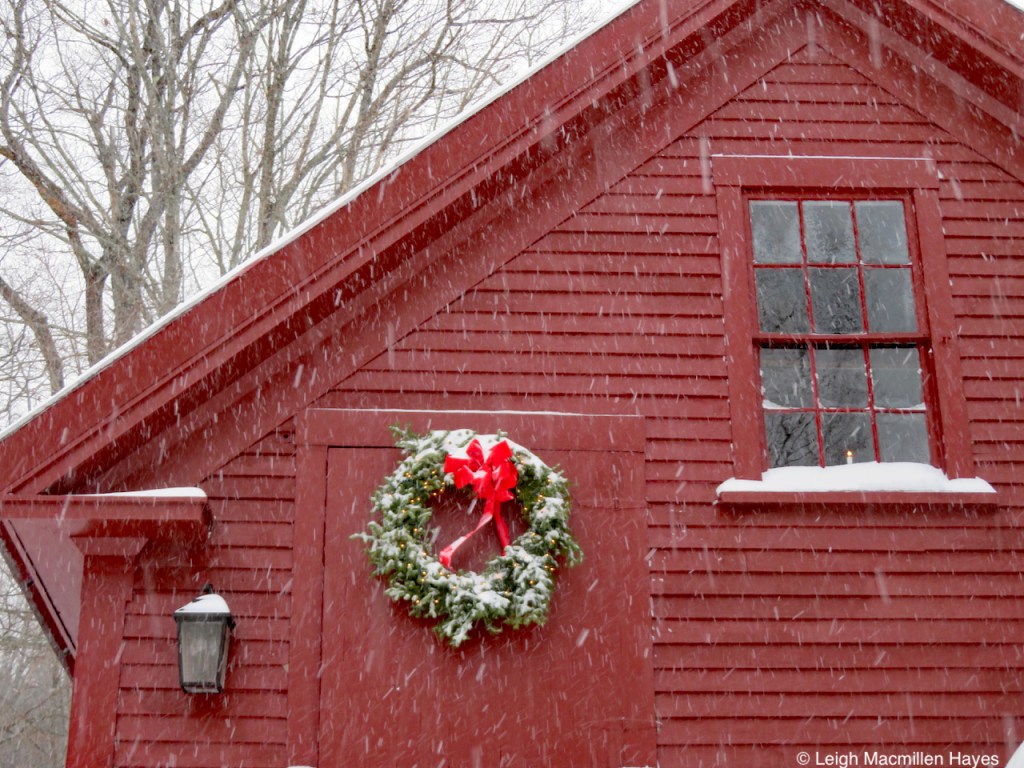
He’d held onto the belief for far longer than any of his classmates. And for that reason, I too, couldn’t let go. And so that day as we drove along I reminded him that though the shopping mall Santas were not real, we’d had several encounters that made believers out of all of us.
The first occurred over thirty years ago when I taught English in Franklin, New Hampshire. Across the hall from my classroom was a special education class. And fourteen-year-old Mikey, a student in that class, LOVED Santa.
Each year the bread deliveryman dressed in the famous red costume when he made his final delivery before Christmas break. To Mikey’s delight, he always stopped by his classroom. That particular year, a raging snowstorm developed. The bread man called the cafeteria to say that he would not be able to make the delivery. School was going to be dismissed after lunch, but we were all disappointed for Mikey’s sake.
And then . . . as the lunch period drew to a close, Santa walked through the door and directly toward Mikey, who hooted with joy as he embraced the jolly old elf. As swiftly as he entered, Santa left. I have no doubt that that was Santa.

And about nineteen years ago, as the boys sat at the kitchen counter eating breakfast on Christmas Eve morning, we spotted a man walking on the power lines across the field from our house. We all wondered who it was, but quickly dismissed the thought as he disappeared from our view, until . . . a few minutes later he reappeared. The second time, he stopped and looked in our direction. I grabbed the binoculars we kept on the counter for wildlife viewings. The man was short and plump. He wore a bright red jacket, had white hair and a short, white beard. The boys each took a turn with the binoculars. The man stood and stared in our direction for a couple of minutes, and then he continued walking in the direction from which he’d originally come. We never saw him again. I have no doubt that that was Santa.

Another incident occurred about seventeen years ago, when on Christmas Eve, our phone rang. The unrecognizable elderly male voice asked for our oldest son. When I inquired who was calling, he replied, “Santa.” He spoke briefly with both boys and mentioned things that they had done during the year. I chatted with him again before saying goodbye. We were all wide-eyed with amazement. I have no doubt that that was Santa.
Once I reminded our youngest of those stories, he dropped the subject for the time being. I knew he’d ask again and I also knew that none of us wanted to give up the magic of anticipation for those special moments we know as Christmas morning, when the world is suddenly transformed.
I also knew it was time he heard another story–that of Saint Nicholas, the Secret Giver of Gifts. It goes something like this . . .

The nobleman looked to Heaven and cried, “Alas. Yesterday I was rich. Overnight I have lost my fortune. Now my three daughters cannot be married for I have no dowry to give. Nor can I support them.”
For during the Fourth Century, custom required the father of the bride to provide the groom with a dowry of money, land or any valuable possession. With no dowry to offer, the nobleman broke off his daughters’ engagements.
“Do not worry, Father. We will find a way,” comforted his oldest daughter.

Then it happened. The next day, the eldest daughter discovered a bag of gold on the windowsill. She peered outside to see who had left the bag, but the street was vacant.
Looking toward Heaven, her father gave thanks. The gold served as her dowry and the eldest daughter married.
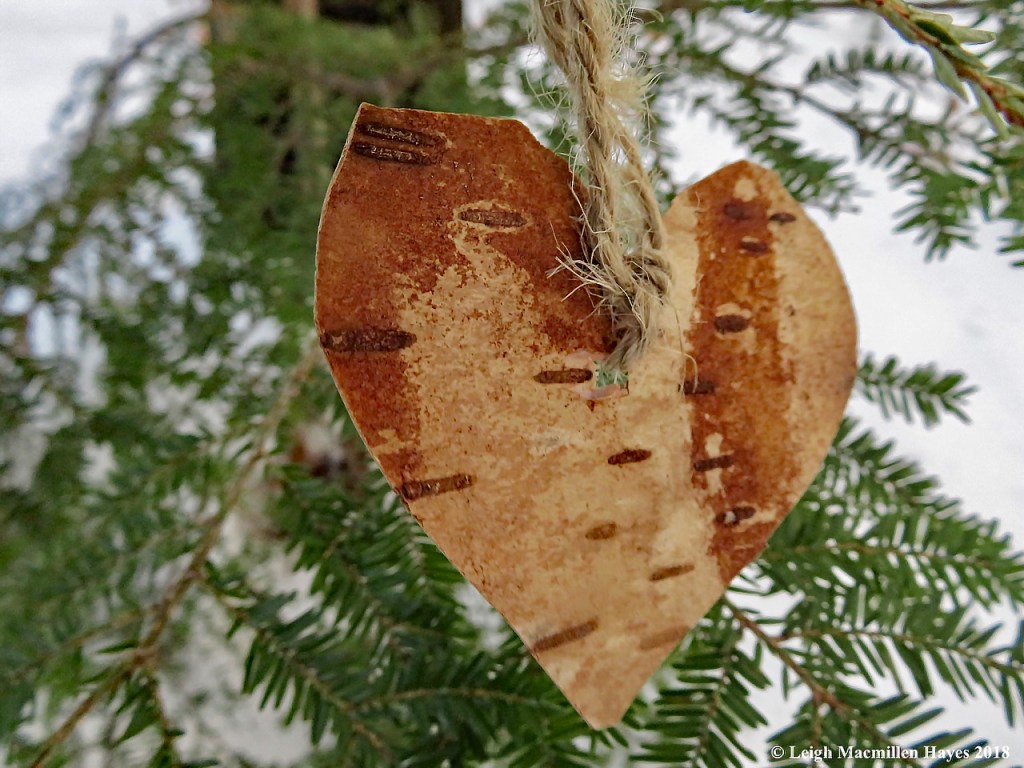
A day later, another bag of gold mysteriously appeared on the sill. The second daughter married.
Several days later, the father stepped around the corner of his house and spied a neighbor standing by an open window. In shocked silence, he watched the other man toss a familiar bag into the house. It landed in a stocking that the third daughter had hung by the chimney to dry.
The neighbor turned from the window and jumped when he saw the father.
“Thank you. I cannot thank you enough. I had no idea that the gold was from you,” said the father.
“Please, let this be our secret,” begged the neighbor. “Do not tell anyone where the bags came from.”

The generous neighbor was said to be Bishop Nicholas, a young churchman of Myra in the Asia Minor, or what we call Turkey. Surrounded by wealth in his youth, Bishop Nicholas had matured into a faithful servant of God. He had dedicated his life to helping the poor and spreading Christianity. News of his good deeds circulated in spite of his attempt to be secretive. People named the bishop, “The Secret Giver of Gifts.”

Following Bishop Nicholas’ death, he was made a saint because of his holiness, generosity and acts of kindness. Over the centuries, stockings were hung by chimneys on the Eve of December 6, the date he is known to have died, in hopes that they would be filled by “The Secret Giver of Gifts.”
According to legend, Saint Nicholas traveled between Heaven and Earth in a wagon pulled by a white steed on the Eve of December 6. On their doorsteps, children placed gifts of hay and carrots for the steed. Saint Nicholas, in return, left candy and cookies for all the good boys and girls.
In Holland, Saint Nicholas, called Sinterklaas by the Dutch, was so popular for his actions, that the people adopted him as their patron saint or spiritual guardian.
Years later, in 1613, Dutch people sailed to the New World where they settled New Amsterdam, or today’s New York City. They brought the celebration of their beloved patron with them to America.
To the ears of English colonists living in America, Sinterklaas must have sounded like Santa Claus. Over time, he delivered more than the traditional cookies and candy for stockings. All presents placed under a tree were believed to be brought by him.
Santa Claus’ busy schedule required he travel the world in a short amount of time. Consequently, as recorded in Clement Moore’s poem, “The Night Before Christmas,” a sleigh and eight tiny reindeer replaced the wagon and steed.
Since Saint Nicholas was known for his devout Christianity, the celebration of his death was eventually combined with the anniversary of Christ’s birth. December 24th or Christmas Eve, began to represent the Saint’s visit to Earth.

Traditionally, gifts are exchanged to honor the Christ Child as the three Wise Men had honored Him in Bethlehem with frankincense, gold and myrrh.
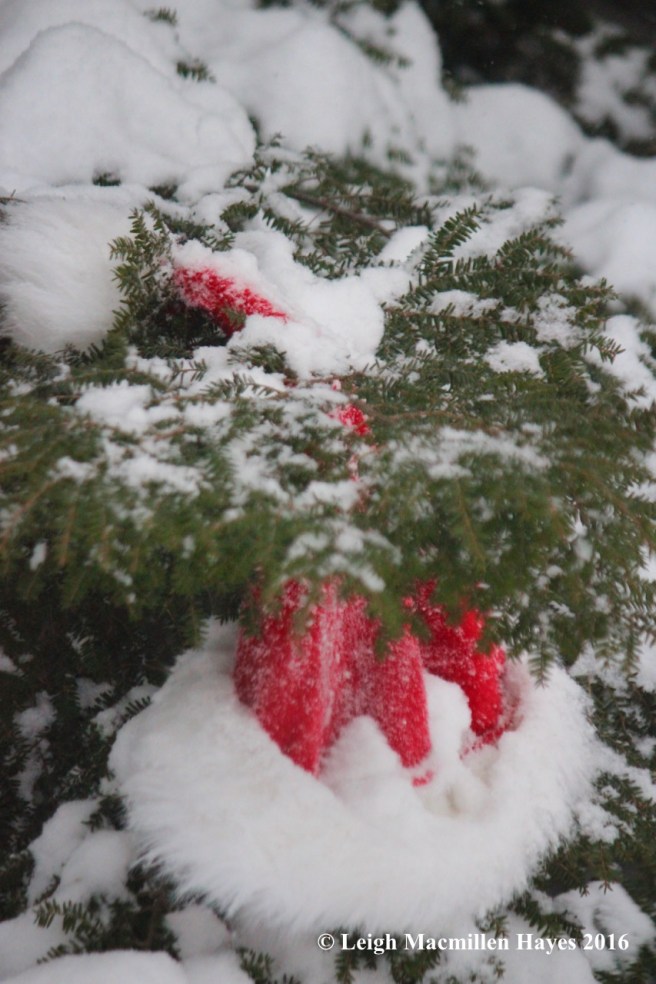
One thing, however, has not changed. The gifts delivered by Saint Nicholas or Santa Claus, or whomever your tradition dictates, have always and will continue to symbolize the love people bear for one another.
Though they are now young adults, my continued hope for my sons is that they will realize the magic of Christmas comes from the heart and that we all have a wee bit of Santa in us. Yes, Patrick, Santa is real.
May you continue to embrace the mystery and discover wonder wherever you look. And may you find joy in being the Secret Giver of Gifts.
Fourteen months ago I wrote Ode to Pinus Strobus, showing my respect for the mighty pines that inhabit our woods. Curiously, it was a rainy day then. And today dawned the same, though even more curiously, today we turned the calendar to December 1, yet the temperature rose to 57˚, like a summer day as we approach winter in western Maine.
Needing a fresh-air break mid-day, I ventured into our woodlot, where part of a fertile fern clinging to a dead tree branch about five feet above the ground garnered my attention. How did it end up on the tree, I wondered. Given that I’d been picking up branches from last night’s gale-force winds, I suspected it had somehow been torn from the rest of the frond and blew onto the branch. Maybe.
Below it, perched in a more stable manner, was a half eaten pine cone and this time my interpretation was much clearer for frequently I’ve been scolded by a Red Squirrel on this trail. He must have been dining on a branch above, out of danger’s way, and for some reason I don’t know, let the cone slip from his front paws where it fell and landed between a branch stub and piece of bark that was partly dislodged from the tree.
A glimpse at the base and I was 98% certain my story was correct for a large midden or refuse pile of cone scales and cobs removed by Red in order to consume two tiny seeds located inside each scale decorated the forest floor.
Because I circled the tree to further examine the midden, and because it was raining, I shouldn’t have been surprised by my next find, but the froth that forms on pines as the result of a chemical interaction when rain drops pick up oils and air in the bark furrows bubbles through that oily film and the end result is pine soap never ceases to amaze me. Plus I love the rainbow colors.
With great patience, I watched the drops drip onto the froth and realized that if I counted to twelve I might get to see a drop just before it let go.
And could almost capture its journey.
As if that wasn’t enough to make my day, I was stepping away from the tree when I discovered a hickory nut on the edge of the midden. One of the manners in which a Red Squirrel opens a hickory nut is to split it in half. Notice the grooves along the edge created by the squirrel’s incisors.
By this time, I was hungry and maybe a wee bit damp, and ready to follow the path home, but . . . a sudden look at the tree’s bark, and I spied life.
The life of a slug is interesting and not to be rushed. No longer was I.
For almost an hour I watched four slugs as they moved at their own slow pace into and out of the furrows of the pine. These terrestrial gastropods (gastro=stomach; pod=foot) create a layer of mucus that they secrete so that the “foot” under almost the entire length of their bodies can move rather smoothly.
Their heads include two sets of tentacles that they can retract (and grow back should they lose one). The upper tentacles are light sensitive and have eyespots at the tip of the stalks. They also use these to smell.
The lower tentacles are for feeling and tasting.
And then there’s the mouth, that funky-looking line to the left of the tentacles in this photo. The radula is a tongue-like organ covered with thousands of raspy tooth-like protrusions–the better to scrape or brush particles from the surface of a tree or plant.
Here’s another cool fact about snails; they are hermaphrodites, meaning each one has both male and female sex organs.
As my snails headed in each and every direction, I at last pulled away, though I did stop to examine other trees on my way home, but found nothing else to look at. 😉 Or at least, nothing else to report.
An hour or more later, I slipped out the door again, curious to check on the action upon that one pine. The fern had blown to the ground. The cone was still lodged between the branch stub and bark. The rain had slowed and froth diminished, though remnants of it remained. The hickory nut had disappeared. And I could only find one slug who was making its way to the safety of its underground habitat.
But . . . because I went back, I spotted an Assassin Bug.
For those who love to wander and wonder, I hope you’ll be still and have an experience similar to what this tree offered me today.
My heart pines . . . naturally.
Today being that post-Thanksgiving-pre-Christmas-better-get-shopping-for-everyone-on-your-list Day, I knew I needed to head out the door.
But I’m a postpone-it-as-long-as-you-can type of shopper and so I didn’t get as early a start as I probably should have because I just wanted to hang out at home for a while.
A few hours later, however, I decided to join the crowd because I was pretty sure that the best deals worth my time and money awaited.
And, of course, they did. First there was the well-chiseled Pileated Woodpecker tree with a sign indicating I could save up to 50%. Into the cart it went. I was thinking perhaps JinMe might like this on her mantel.
Surely Faith and Sara will enjoy this ice sculpture–that is really a bunch of hidden pictures. I won’t let on how cheap it was, but even if I did, I suspect they wouldn’t care because, after all, it’s the thought that counts.
For Pam, there was that one-of-a-kind bird nest decorated with curly wisps of paper birch bark and enhanced with an acorn. I know she loves a mystery and suspect she’ll enjoy trying to figure out who created such, cup-shaped and located in the crotch of maple sapling.
For the other Pam, I put a limited-supply pond-scape photograph on layaway. It will serve as a memory of that day long ago that we passed by a barn, followed the S turns on a snowmobile trail, crossed over a number of water bars, looked for the point when the trail started to feel like we were descending rather than ascending, found a hemlock grove (or did we?), and looked for a sign we never saw, but decided to bushwhack instead to the edge of a certain pond. I couldn’t afford the entire price of the photo today, but with weekly payments, I should be able to wrap it in time to place it under her tree.
Four hours of shopping later and I was done in, not being much of a shop-till-you-drop person. I have so many others on my list, but in due time I’ll again force myself to join the crowds and snag further discounts and get something to show my appreciation for all.
I was just about to head to the check-out when I learned of a limited-supply item. You rarely find brand new products on sale so soon after being released, but there it was, a bear nest in a beech tree, that spot where a bear sits high up in the tree and snaps the branches to pull it inward in order to dine on beech nuts. I knew I had to get it for Bob. He really wants a partridge in a pear tree, but I think this doorbuster sale will suffice. Or maybe it’s a treebuster doorbuster sale. 😉
To feed or not to feed? That is not the question for I know I will continue to put out bird seed from now til April or May since it provides them with a constant food source and me with a constant entertainment source.
But still, things happen, like Gray Squirrels figure out how to access the squirrel-proof feeders.
And when I least expect it, everyone makes a mad dash because a bird of prey suddenly rockets in with talons extended.
I’d only placed the feeders in the yard a few days ago, but today this Cooper’s Hawk explained why I keep discovering feathers on the grass. Do you see the gray feathers by its talons? Tufted Titmouse? That makes me sad, but . . . raptors need to eat too.
Meanwhile, a female Northern Cardinal who had been feeding on the seed I spread on the ground tried to take cover in the grass. Notice how her crest is raised? I suspect it stood tall indicating her worry.
Even after the hawk flew off, she remained in the same spot. But, do you see the difference? The crest began to drop, perhaps because she began to relax.
I could almost hear her say, “If I don’t move, he won’t see me.”
About 15 minutes and lots of raindrops later, she finally perused the yard.
And let a few more raindrops gather on her feathers before flying off. I was grateful to see her fly, because for a while I worried that she had been injured in the fracas. My other thought was that she might be in shock. But, I think for now, until I learn more about bird behavior, I’ll stick with thinking she was playing it smart and waiting for danger to pass.
Two hours later, I spotted the hawk on our stonewall and later went out to search for feeding evidence as chipmunks and other small mammals are also part of their diet. I found only a couple of downy feathers where the bird had stood in the yard and nothing by the stonewall, but I suspect there may be something to notice in the future.
Today’s drama all happened in a flash and as odd as it may seem, I was grateful to be a witness.
My mission was two-fold. Hike up a small mountain and capture a one minute video to post on a work website next week, and retrieve a game camera so we can download the photos and then place in a different location.
And so it was that on this brisk morning, snow-capped Mount Washington greeted me. If you zoom in, you might see the buildings at the summit.
Because I was at a different summit that I frequent, I knew I had to check on the activity of the local residents and wasn’t disappointed. First, I followed their trails, where leaves are well packed. Those led to trees, but no downed nip twigs as one might expect. That could only mean one thing–there are still plenty of acorns on the ground for them to eat. Because I was searching, however, I was thrilled to discover one sign that the season is changing. I knew that by the five layers I was wearing, but the stripped bark and cambium layer of a birch indicated the same. A porcupine’s diet varies with the offerings and part of their winter dining includes just this. Notice, too, the pattern of the incisor marks. Such a design thrills me no matter how often I encounter it.
One of the porky trails led into a crevice below where I stood. It was there that I caught the first glimpse of icicles and knew I had to climb down. My route wasn’t the same as the porcupine’s for I’m not quite as nimble on rocks and slippery leaves.
But, with grace, I descended and made the surprise discovery of Mount Rushmore East. At least, that’s how the rock faces looked to my eyes.
But seriously, I wanted to spy the icicles from below and they became the inspiration for next week’s GLLT Moment.
That wasn’t all I wanted to spy and I wasn’t disappointed for the trail of scat indicated one potential den site.
And more scat led to another. I suspect those aren’t the only two, but I wanted to keep moving, such was the temp.
That said, right beside the second porcupine den, I found a small hole in the ground capped in hoar frost and suspected that someone was inside. It seemed a bit larger than a chipmunk hole. Maybe a squirrel? Or a weasel? Or even, the porcupine’s den vent?
While those choices rolled around in my brain, I climbed up the ledges and made my way down the trail until it intersected with another. Eventually, water once again stopped me as it often does.
Only two weeks ago the temperatures in western Maine were in the 60˚s and 70˚s, but the past few days have been chilly and already dancing elephant legs are forming over sticks that dangle above moving streams.
Even the froth created by the friction of the stream’s movement had frozen in place.
I stopped a few more times, but finally reached the spot that was my second intention of the day. While exploring in this area a couple of week’s ago with several Greater Lovell Land Trust docents, we noticed beaver trees. The work looked rather recent and so we set up a game cam in hopes of getting a view of the perpetrator.
Today’s visit, however, showed no fresh work on this tree.
And a skim of ice indicated no one had recently walked out of the water. I snagged the camera and dropped it at the office so the photos can be downloaded. I hope they reveal more than a few test pics of us homo sapiens.
It was while heading back to my truck that this splash of color caught my attention. Notice the Striped Maple leaf on the mushroom–they are like a matched set. I’ve been torn in my identification between an Artist’s Conk and a Red-belted Polypore, whose belt is not always red.
But more important than identification was presentation. And the knowledge that the middle mushroom grew when the tree was still standing, while the others fruited after the tree had fallen, for mushrooms must always orient toward the ground, the better to spread one’s spores, of course.
My final sighting of the day, that still has me smiling, occurred in the middle of the adventure, but I wanted to save it for last. Do you see what I saw?
How about now?
Surely now you can.
Who cooks for me? I wish this Barred Owl would, for I must now prepare dinner. But that’s okay because I’ll take him with into the kitchen in spirit and give thanks that I had the opportunity to spend a few minutes with him . . . all in a day’s work.
Artifacts. In the woods. A sign.
A sign of the past and the present. A sign of people. A sign of nature.
The people story may have ended 72 years ago in this space . . .
but the nature story continues with many interesting twists and turns along the way.
The people may have tried to defy nature . . .
but nature has a way, whether we like what emerges from it or not.
And figuring out the procession of the nature story, as much as some of it may not please us, is still intriguing.
People and nature.
People versus nature.
Who wins? In the end, nature reclaims her own as the lichens demonstrate on this quarried granite.
I love November. Maybe because the first snowflakes typically fall. Maybe because the air is crisper (except for last week, that is). Maybe because the days are shorter and I love being embraced by darkness.
Maybe because the color palette is all its own after the reds and oranges and yellows of October and before the white and gray and evergreen of December.
Maybe because we might have one last chance to visit this special place before the gates are closed on the forest road for winter.
Maybe because we get to see Mergansers swim and dive and fly and slide into a landing over and over again.
Maybe because if we look closely, we might just spy a Bullfrog tadpole swimming.
Maybe because in the middle of our looking here, there, and everywhere for a moose, or some otters, or even a beaver family, we may suddenly spy a little red flyer.
No maybes about it because this Autumn Meadowhawk took a while, but eventually let me coax it onto my hand today. Why is it still flying? Maybe because we did have a warm up this past week, though the past two mornings Jack Frost has visited. Whatever the reason, it certainly took us by surprise on this November day.
NOTE: previously, the latest I’ve seen a meadowhawk fly was Nov 4, 2019.
Yeah, so on Sunday my guy and I hiked about four miles all told and found three geocaches in the mix cuze he’s now hooked, which is fun on my end since it slows him down a wee bit.
And on Monday–almost eight miles covered. But it wasn’t the mileage that mattered. Really.
Our morning began beside still waters. Well, the water was hardly still, but considering how crowded the area can be on a summer day, it was a delight to be the only two human beings in that space for those moments.
It’s a cool spot on many levels. No, we didn’t slide into the pool below; nor did we jump off the 20-foot cliff. Rather, we stood in awe and appreciated. That is, after finding another geocache located nearby.
Eventually, we pulled ourselves away because there was more water to meet, though we were surprised to arrive at a closed gate. No signs forbid our trespass and so we walked around the gate, and up the dirt road to the parking area and kiosk. On the way, we could hear a machine being operated and wondered if we’d stumbled upon a logging operation. A few minutes further along, a young man with an easy grin pulled up in a pick-up truck and knowing that the gate behind us was closed, we figured he must have something to do with the property. Sure enough, he told us they were working on the roadway and bike path ahead. The gate is closed for hunting season, but will reopen in the winter. Still, we were welcomed to hike on.
Half a mile later, we slipped into the woods and left the machinery sounds behind.
Occasionally, we walked across bog bridges and into the future.
Looking down at our feet was a constant, given that there were lots of slippery beech leaves to contend with, but . . . beech leaves mean one thing: American Beech Trees. And much to our delight, smack dab beside the trail stood a well-used beech tree. Some of the claw scratches weren’t all that old, given the width of the scars, and though this year proved to be yet another mast year for Northern Red Oaks (is it just me, or have red oaks been producing acorns on a yearly basis for at least the past five years?) it wasn’t so for the beeches. But perhaps last year or the year before or maybe a few years ago, this tree was a magnet for Ursus americanus.
We could have turned around then for our hearts were delighted, but, of course, we didn’t and soon found ourselves beside a single-wide stone wall.
Barbed wire that a tree had grown around told us the wall was intended to keep animals in . . . or out, depending on your point of view.
Certainly the tree knew, and had we spent a few more minutes with it, I suspect it would have quietly shared more knowledge with us, but we were on a quest and knew we only had so much daylight left.
And so, we hiked on. Until we reached one rather large blow-down and wondered: if a tree falls in a forest . . . Our answer: it land on the ground. Presumably with a thump. And this one must have created a ground-shaking thump.
Not far above the tree, a fanciful picnic table graces a knoll, and invites all questers, including this guy, to pause.
He didn’t pause for long. Back on the trail, as we climbed higher, the naturally community did what it does, and changed. For a bit, the delightful aroma of Balsam Fir spurred us forward, both by our feet and by our thoughts of the holiday season to come.
At last we reached water, and I thought our quest might be over. Could this be what we sought? As much as I loved watching bubbles form and pop, I was rather disappointed.
But after crossing rocks to get to the other side, the fall coloration of Tiarella (Heartleaf Foamflower) in all its hairiness called for attention.
And then, as we entered an opening where pine saplings grew in the sun, one showed off its crosier-shaped leader–bent over as commanded by a pine weevil. The tree will grow, but the live whorl of branches below will take over as leaders and change its stature.
Did I mention that the natural community kept changing? My guy and I soon realized that that was one of the things we really enjoyed about the trail, for there was so much diversity. And just steps beyond the weeviled pine, we entered a beech stand, where you know who had lumbered before us.
As much as we knew we needed to keep moving, we couldn’t help but search and didn’t have to stare far off trail to see evidence of so many bear claw trees. We figured we spied at least 25, though ask me tomorrow and I may say 30. They were everywhere and we wondered how many more we had missed.
But . . . there was more to see and so down a portion of trail that the young man we’d met had created all on his own and opened only last week, did we tramp. It was so new that the ground practically sprang under our feet. Can ground sprang?
We’d reached our quest at last and had to hurry three plus miles back as quickly as possible, promising each other not to stop and recount the bear trees, and we emerged at the parking lot as the sun was setting, with only the half mile walk down the road to our truck left to complete.
Oh, but what was our quest? It wasn’t a geocache this time.
And it wasn’t the bear trees; though they were a bonus.
Rather, it was the water that cascaded forth in three locations on this Mondate and already has us dreaming of return visits–though on a day when we either begin hiking earlier or there’s more daylight so we don’t have to hike down in twilight.
Thank you, Rosemary Wiser, for hiking this trail before us and giving us the inspiration.
My guy doesn’t make it easy to come up with birthday or Christmas gifts, but one thing I’ve learned over the years, and it’s taken me many years to figure such out, is that he loves a challenge. Especially when we’re hiking. So . . . there was the Amazing Race–our style and the Bear to Beer Possibilities and now . . . a birthday list of geocaching finds to seek. Or is it seek to find?
His birthday may have been almost a month ago, but we didn’t start our latest quest until today, a day that started and ended cold and blustery, but began in a place where a few Tamaracks shone of their autumn foliage. Why do I love these trees so? Perhaps because each time I see one I am taken by surprise.
Perhaps because they can’t decide who they are: deciduous or coniferous or a deciduous conifer? It’s the latter, for sure. What I appreciate most is the fact that it represents both. It rather reminds me of my brain where left and right meet on a Myers Briggs test and encompass the best (and sometimes worst) of both worlds.
But I digress, and so back to the trail. We followed two today, and one of our first finds was that tree we always covet. A bear-claw tree, this one a favorite and oft visited given the claw marks that decorated it.
Of course, as things go in the natural world, or any world for that matter, where one finds delight, there is also something not so delightful taking place. In this case, Beech Bark Disease that begins with many Beech scale insects feeding on the tree’s sap while they form a covering of white wooly wax over their body. The scales create wounds in the trunk that allow the nectria fungus to enter bark, cambial layer, and sapwood, thus producing cankers, or raised blisters and calluses.
As if that isn’t bad enough, because eventually it will kill the tree, tarry red spots ooze from the cankers like blood from wounds.
It would be so easy to spend our day looking for all the bad in the woods, but we chose to focus on better things as we moved forth and so to a wetland did we arrive.
Standing there in silence, the sky kept changing while the wind gusted to at least 20 miles per hour and snow flakes fell.
Across the wetland, it was obvious that some had been preparing for temps such as today’s for the beaver lodge appeared to be well mudded and winter decorations set, only in need of holiday lights.
And speaking of Christmas, a surprise gift appeared under the beaver lodge trees . . . in the form of a male Hooded Merganser.
He moved to the right and then the left while the snowflakes fell and what struck me was how the reflection of his hooded crest resembled the surrounding birch trees.
From that place we drove to another for our quest continued. And it was in the second place that we smiled at the discovery of a neighborhood library.
But it was the water flowing behind the wee library that quickly diverted our attention. While we appreciated the structure over which it flowed, we didn’t realize its true significance until we traveled further down the trail.
Faded interpretive signs told the story of the past, but I only skimmed those. What I did learn was that the foundation upon which I stood had once been a powerhouse, thus the importance of the water flowing from above for saw mills, grist mills and such. And as I stood there, I noted the structures that once supported a penstock and then the location of a turbine that must have been situated within the powerhouse and I gave thanks to my friend Sue Black (RIP Sue) who long ago helped me gain a better understanding of these structures along Stevens Brook Trail in Bridgton, Maine. As serendipity would have it, her son, Andrew, had contacted me only a few hours earlier about an unusual natural sighting he’d made.
Climbing down to the penstock, it was well worth the effort to gaze toward the powerhouse below . . .
and flow from the dam above.
Around another bend south of the powerhouse, the water calmly mirrored its surroundings.
Oh yeah, the surroundings. We were supposed to be searching. And we did. Successfully, I might add. Actually, it was my guy’s thing to search and he was well rewarded.
Today, thanks to geocaching.com, he scored two discoveries, including this well-hidden micro. We still can’t believe the creative hide or the fact that we found it, though to be honest, we looked for a bit, thought about clues, went back to the truck to eat lunch and reconsider our strategy, and then headed out again. I was about ready to give up, when suddenly I heard him exclaim, “I found it.” I did have to explain to him about Muggles and the proper way to quietly announce a find a few minutes and feet away from making such a discovery.
As I suspected, he was hooked and is already talking about our next adventure. For both of us, we treasured the hunt and the finds we each made.
With Halloween only a few days away, the woods are alive with “ghoulies and ghosties and long-leggity beasties, and all things that go bump in the night.” Well, maybe it’s supposed to be only the night, but during the day spirits certainly seem to make their presence known.
And their homes as well, this one serving as a mansion.
Sometimes they dance quietly from tree to tree or scamper loudly across the forest floor, but still others . . .
roar through the landscape with the flow of water.
In the mist, or midst, others are always there; you just need to look and listen. Do you see one watching?
As loudly as some may seem at times, with the look of an eye, they can quickly transform to sudden calm.
The ghoulies and ghosties of these western Maine woods come in all shapes and sizes, as do their homes.
And it’s those homes that can also leave one wondering. Who lives here?
Who could possibly live in this tree that despite its hollow trunk still produces leaves?
Why, one who often goes bump in the day. And the night. And loves to have fun in the woods.
You must be logged in to post a comment.